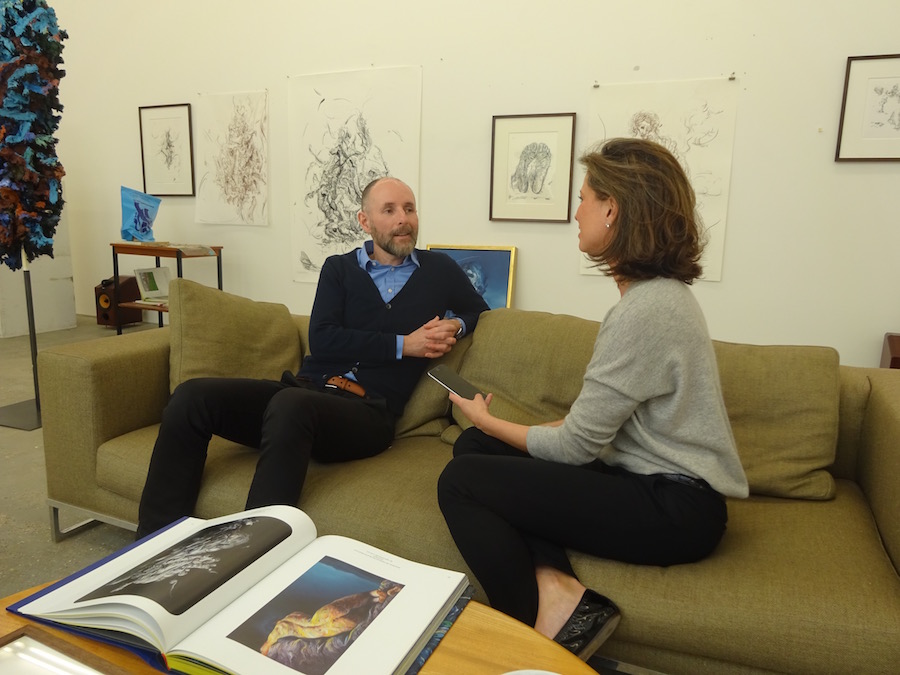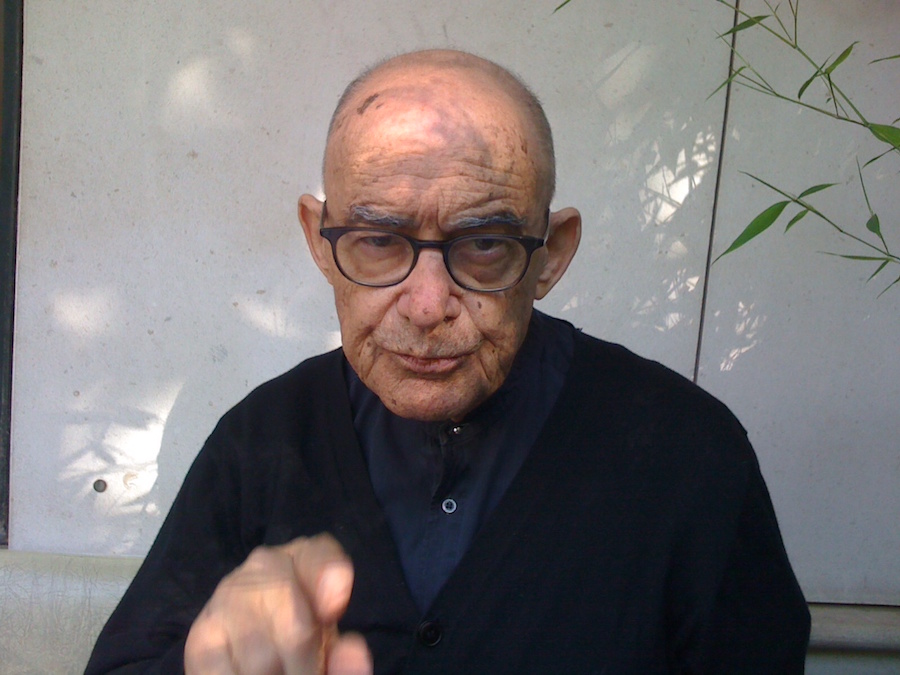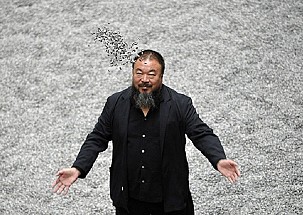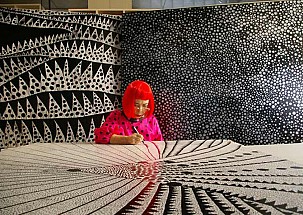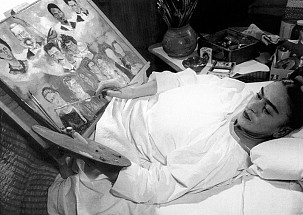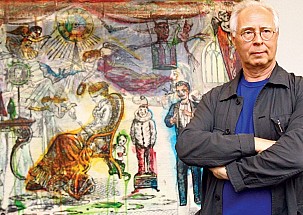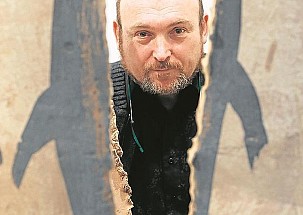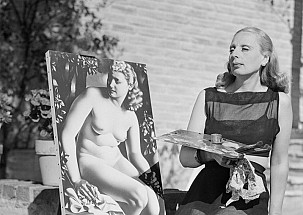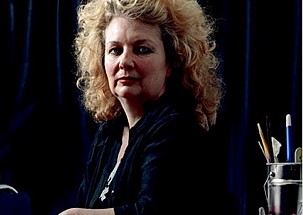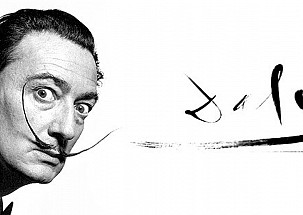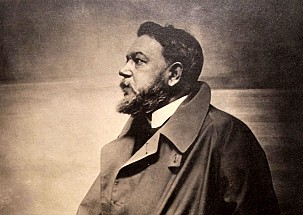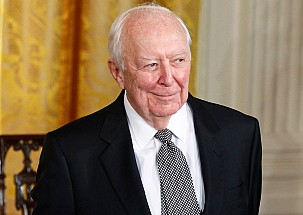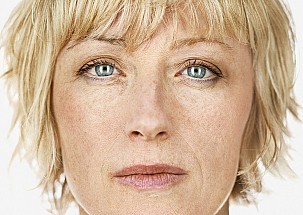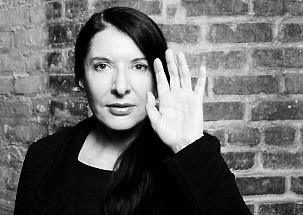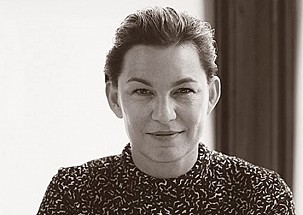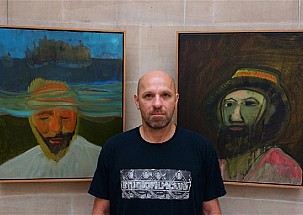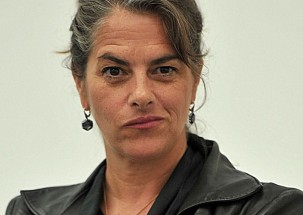- Details
- Written by Elena Cué
Ed Ruscha (1937, Omaha, Nebraska) is one of the survivors of the American Pop Art, movement that has maintained it's influence since it emerged in the mid s XX until now. His work articulates images and words, providing them with a multiplicity of meanings, prompting thinking. Through Ruscha we can travel by car along California landscapes: roads, buildings, and billboards, where images and texts are intertwined. His work has been exhibited in the best museums in the world, such as, among others, in the Whitney Museum in New York, the Centre Georges Pompidou in Paris or in Spain in the Reina Sofia Museum. Despite his nearly 80 years of age he retains all his charm and appeal, physically and intellectually. On the occasion of his last exhibition in the Gagosian Gallery of London, we talk about his work and career.
Author: Elena Cué
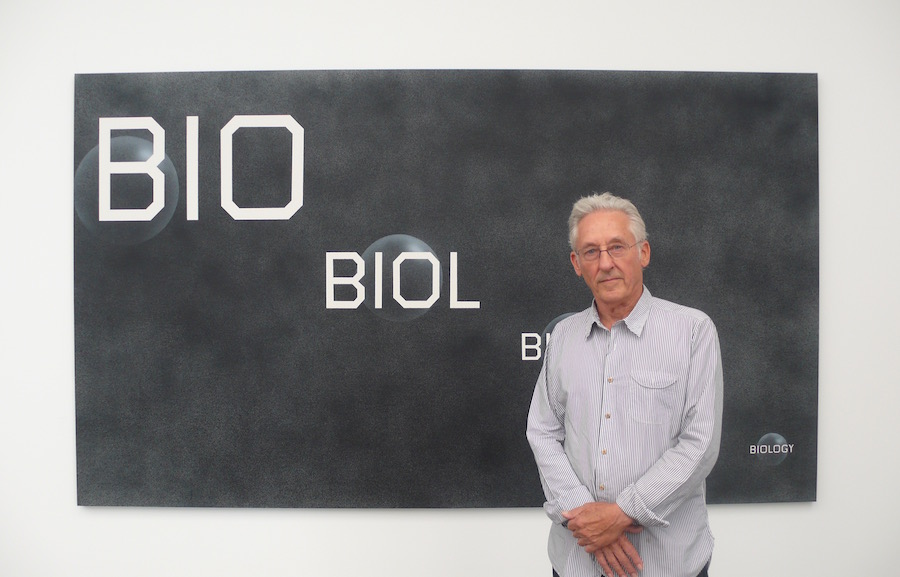
Ed Ruscha. Photo: Elena Cué
Ed Ruscha (1937, Omaha, Nebraska) is one of the survivors of the American Pop Art, movement that has maintained it's influence since it emerged in the mid s XX until now. His work articulates images and words, providing them with a multiplicity of meanings, prompting thinking. Through Ruscha we can travel by car along California landscapes: roads, buildings, and billboards, where images and texts are intertwined. His work has been exhibited in the best museums in the world, such as, among others, in the Whitney Museum in New York, the Centre Georges Pompidou in Paris or in Spain in the Reina Sofia Museum.
Despite his nearly 80 years of age he retains all his charm and appeal, physically and intellectually. On the occasion of his last exhibition in the Gagosian Gallery of London, we talk about his work and career.
Your latest works are shown in this exhibition "Extremes and In-betweens". On the canvas, against a painted backdrop, a series of oversized words gradually fade out and their meaning goes from the universal to the specific, almost disappearing.
You know, I think that this work comes from a book that I made in 1968 called Dutch Details. I was invited to the Netherlands to make a project. I wanted to make some pictures in this little northern town of Groningen in the Netherlands, so I took photographs and it was like a progression. I took pictures across a bridge one very wide picture and then I walked forward, took another picture, all the way across the canal to the window of someone’s home and inside the window were flowers in a vase. And somehow, that’s always stayed with me, so I think that these works come out of that spirit. I think that anything I do as an artist comes from something that I did years ago and so I’m just a variation on a theme.
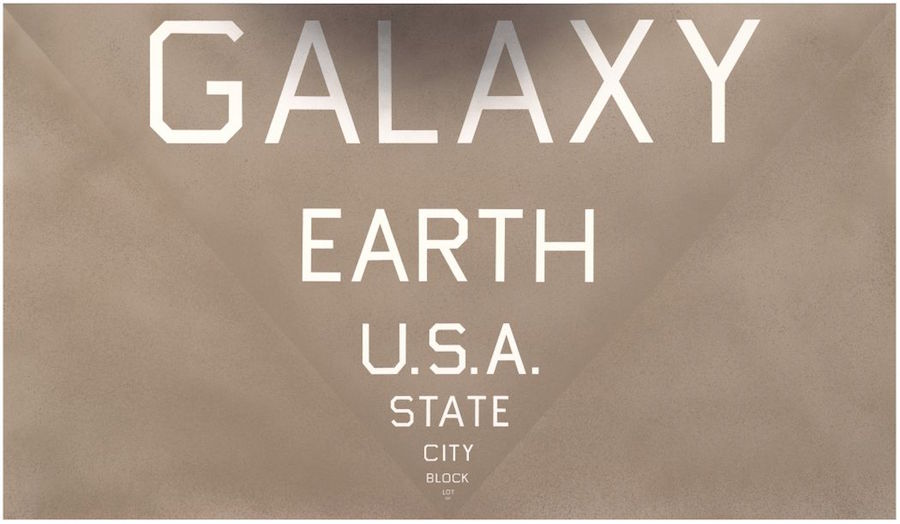
Ed Ruscha, Galaxy, 2016. Photograph: Ed Ruscha/Courtesy Gagosian
Then usually, your inspiration comes from your memory?
Yes, but also things that I see in the street and in life, I’m influenced by all these things. But it usually is somehow affected by things that I did many years ago. So when I was 18 years old, I maybe had the basis of what I do as an artist. And everything I do is just a little bit off of that.
Could you describe your pictorial evolutionary process, from a more emotional art like abstract expressionism to the more rational conceptual genre?
Yes, in some ways I feel like abstract art is everywhere and it’s quite an achievement. It’s a very modern step forward, the invention of abstraction. You know, 150 years ago people starting making abstract art. And it was a really important step to do art that is not figurative. And so abstract art affects everything that I do, and that most people do. You know, every artist wants to open the gates to heaven and I’m really no different. I’m influenced by almost everything I see: bad, good, in-between.
You have described yourself as an image-maker; could you tell me about that?
I love abstract expressionism. For me, unlike the artists who cultivate it, I’m better when I think of something in advance and then plan the painting out. I have a preconceived idea about what I want to do. So that’s my approach, and in many ways I don’t think like an abstract expressionist. I think like a person who plans the work out.
So it is more conceptual than emotional?
Yes, but emotion can enter too.
But mostly control…
Yes!

Ed Ruscha, Hollywood, 1968. © 2012 Edward J. Ruscha IV. All rights reserved. Photo © Museum Associates/LACMA
Your landscapes of broad horizons, raking light, twilight mystery, dramatic sunsets, desolate places… I find enormous romanticism in the immensity of your landscapes, a sort of modern Caspar David Friedrich. Is there romanticism in your work?
I don’t put romanticism in my works, but I hope that it’s already there. I love Caspar David Friedrich’s work. But you know, he was a very individual and impressive artist. It’s hard to describe him, but I see so much in his work. And not just the figure that’s standing looking out over the horizon but he did drawings and paintings of ice that was fractured; they look like geology. You know, his work is great.
Yes, it beckons one to look beyond, towards a metaphysical dimension. Are you interested in what lies beyond the physical?
I certainly don’t think of my work as being mystical or cosmic. It’s more simply my contact with the world as it is, so I don’t delve into mysticism. I know a lot of artists do; they believe in that. But I’m maybe not there. I’m more practical I guess, or visually sometimes I don’t know where I am with it, and I’ve been doing this for so long that I forget why I’m doing it!
Your work is full of meaning...
Somehow my work took on the elements of words and English language, and somehow I got onto that because I studied printing and I wanted to be a sign painter. From there it went to printing, to books - I love books and I’ve made books for many years. So those elements are there, I can’t escape this. And I don’t want to escape it either, it means a lot to me.
In some of your paintings these words or texts have contradictory meanings with the image. They convey irony, humor. What is your intention?
Well I don’t set out to make something that’s funny. Irony is another subject – I mean it’s just the basis for my thinking. It comes from all different directions. When I did these paintings here, I had to establish some kind of platform for my thinking and a lot of it had to do with color. I wanted to establish a color and I arrived at this raw umber. I like raw umber – it’s almost like a color that forgot it was a color. And so I thought, that’s the answer right there. To make a stage setting for these thoughts that are the progressions of thinking – you know, whether it’s time or whatever it is - it all just has to come together somehow.
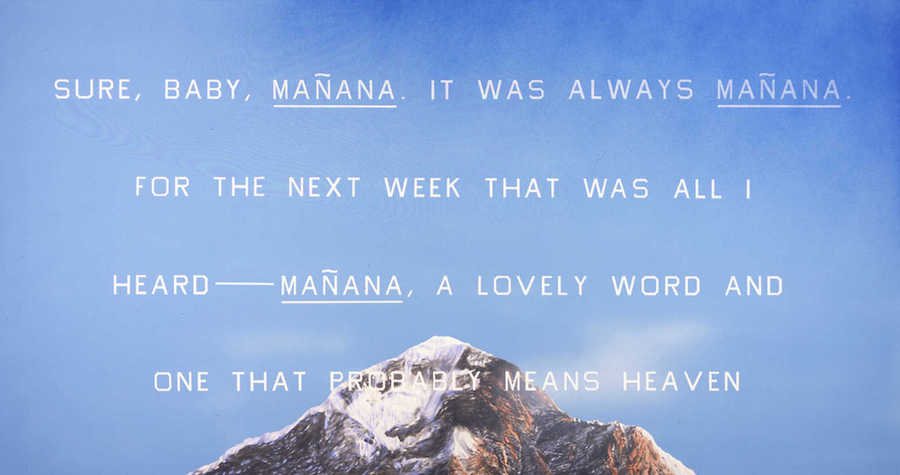
Ed Ruscha, Manana, 2009. Courtesy of the artist and Gagosian Gallery.
What disturbs your mind? What drives you to paint?
I think that everyday life is enough to produce the incentive to paint. It’s not necessarily the torture of unknown things that make me want to explain that. It’s like living in an isolated world and somehow working within that world with the limited tools that I have and so I just keep working. To explain it is difficult.
You do not appear to be one of those tormented artists…
Well a tormented artist might be somebody who is an artist one moment and then is not an artist and it’s a struggle. For me, the immediate struggle never really happened but there are all kinds of elements that enter into the making of art and it’s not all joy and flowers and sweetness, you know. But at the same time, it’s not all torture either, so I just see things that I want to make a picture of, and then I make pictures.
Your photographic series of buildings, gas stations and swimming pools are presented as sequential documentation. Where does this passion for the artist books come from?
Probably from childhood and traveling, and things I see that are beyond childhood. When I was introduced to the real world, I was introduced to traveling and especially in the western United States. So I was driving a lot and traveling over the west and I began to see gas stations. And so my camera was a voice for me, and I wanted to somehow record this and make - not just photographs - but I was very curious about the concept of a book. It was very magical to me. Taking the book and starting out with thinking about a book that is empty and has no images, no writing, nothing. And then you take the book with its very clean, empty pages and somehow filter your thought into these empty pages and make a story or an idea, and develop it. And so books to me are like making art.
One of your pictures downstairs is like an open book…
Yes, it drives me crazy. It comes up in a lot of my work of the last ten or fifteen years, this idea of opening up. And sometimes I don’t even know that I’m doing it, so it’s just very spontaneous and open.
And, what is the relationship between your art and movie-making?
I saw many movies as a child, and the old movies were on giant screens. There’s something really magical about that, it makes a big impression on my life. In many ways, it’s like looking at a painting - except the painting doesn’t move - and here you have something on the wall that is moving and also telling a story and giving you music! So in many ways, painting is to me very influenced by movies. And then movies began to open up, the format becoming wider and wider, until you have Panavision… panavistic. So I started making paintings that were very wide and skinny like this, and it’s like opening the horizon. Making it wider, giving you more. And somehow that had a lot to do with seeing movies.
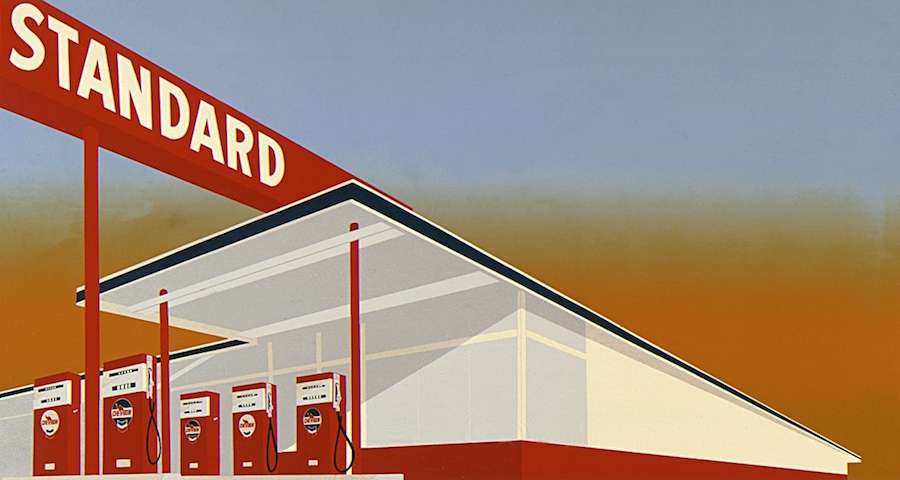
Ed Ruscha. "Standard Station", 1966
Your interest in architecture, and specifically in petrol stations is evident. What fascinates you so much about architecture?
I can imagine when I first saw the gas stations. I loved the little house, and there’s always a roof overhang that come over the top of the gas station where cars are pulling in underneath to get gasoline and drive off. And this little house at the back was so comical. So gasoline stations gave me my first exciting introduction into the world of architecture. And I even had dreams of maybe living in one of those gas stations sometimes, where you had this little room in the back. Architecture was always reduced to that for me, so I have a very fundamental belief in the simplicity of architecture.
You have experimented with all manner of materials, including organic substances such as food and drink, dynamite etc. You took part in the 35th Venice Biennale with Chocolate Room. How did this experimentation begin?
I saw that painting a picture was like putting maybe a skin onto a canvas, where it sits on the top of the canvas and I began to feel uneasy about that. I thought the idea maybe should be to stain something, where it goes down into the surface. I could see that organic materials and unconventional materials like axel grease or something – or if you take flowers and rub them into a canvas - all go down into the canvas, they don’t just sit on top. So making images out of something that is not paint made it very intriguing for me and interesting. I think it just offered another opportunity to do something. I was tired of painting on a surface. Now I’m back to painting a surface, you know! But in my work I have a lot of things that I can’t explain; I never liked airbrush art, but then I find myself doing airbrush art. And I never liked shaped canvases, but now I find myself doing it.
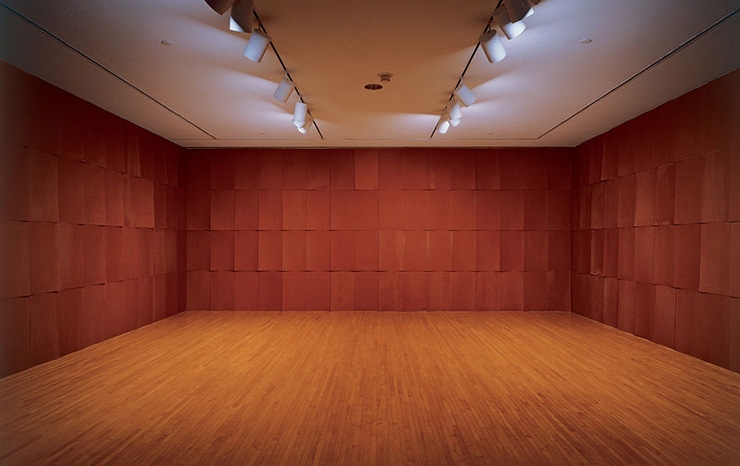
Ed Ruscha, Chocolate Room, 1970.
The external influence that the Californian landscape has, is evident in your work. However, where do you find your inspiration or the stimulus for your more conceptual work?
It goes back to nature. There are many modern things that I appreciate, but then I also love going back in my mind and seeing. I like the desert a lot, just the emptiness of it and the drama of the desert and the cacti and the vegetation and the animals and the no people idea. I mean, I love emptiness. So that also has a big effect on everything I do as an artist. It’s nature and it’s also popular culture, so I’ve got a mix of those things.
Speaking about the emptiness... why did you choose not to include people in your paintings?
When I first met Andy Warhol, I gave him one of my books of gas stations and he looked through each page and he said, oh I love it, because there are no people in it… and I’d never thought of that. I didn’t realize. Well yes, you’re right; there are no people in there. I was stunned. So I have no compulsion to describe a figure with paint. And so I don’t.
What is the most frustrating aspect of your work and which is the most rewarding?
I thought at one time that the thing I really want to have when I make a picture is the finished product. But then there’s also the getting there, the things you have to work through and the mistakes you make. Sometimes mistakes are very good. And if you turn a mistake into something that is positive, then that’s part of the end product.
How do you feel when you look back at your own work, for instance, in a retrospective exhibition. Does the distance of time render them remote from who you are today?
No, it’s actually very close. I mean, I think that things I did many years ago are very close to me today and that I’m not that far… maybe that means that I’ve not progressed very much! But when I started, I had no thought of ever making a vocation, making a living of my art. I had no concept that people would buy art and allow me to live off of it. And most of my friends were the same, you know. We did it for the glory of it, and to impress one another. The idea of making a living out of it was never there. And then the real world kicks in, and here we are!
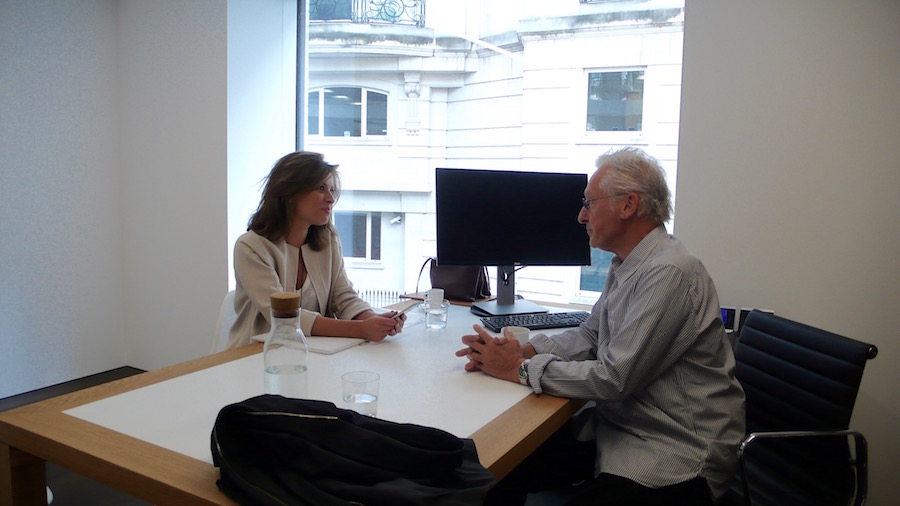
Ed Ruscha. Photo: Elena Cué
- Interview with Ed Ruscha - - Página principal: Alejandra de Argos -
- Details
- Written by Elena Cué
Adriana Varejão (Brazil, 1964) articulates the arts: painting, sculpture, photography or architecture with a contemporary baroque style. Beneath a complex conceptual process lie principles such as identity, assimilation, anthropology, the body… stemming from her deep-rooted historical and cultural heritage. The three centuries of Portuguese colonization are reflected in her works by way of mosaic tiles, water or flesh, with references made to the primitive history and the indigenous identity of her country; as well as in the excess, the monumentality, the dramatic esthetics displayed in her penchant for the baroque. An art full of symbolism, of the bends and folds so typical of the esthetics of the period. At the same time, bodies that are objectified and then desecrated. Destruction and annihilation in the colonization process, but also assimilation and the creation of new values, in step with nature.
Author: Elena Cué
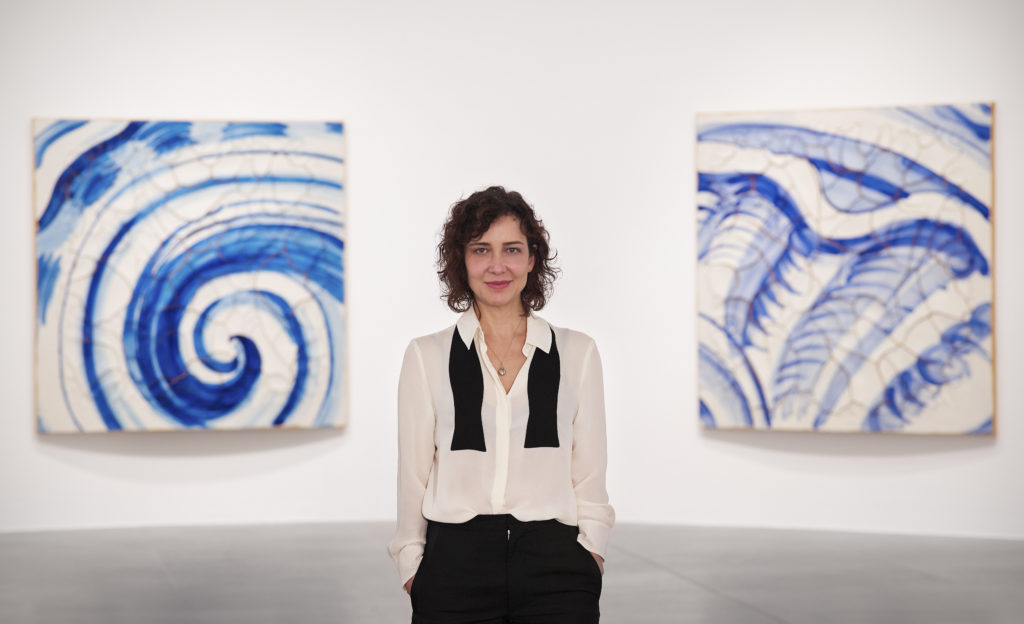
Portrait of Adriana Varejão. Photo by: Matteo D’Eletto M3 Studio © Gagosian and the artist.
Adriana Varejão (Brazil, 1964) articulates the arts: painting, sculpture, photography or architecture with a contemporary baroque style. Beneath a complex conceptual process lie principles such as identity, assimilation, anthropology, the body… stemming from her deep-rooted historical and cultural heritage. The three centuries of Portuguese colonization are reflected in her works by way of mosaic tiles, water or flesh, with references made to the primitive history and the indigenous identity of her country; as well as in the excess, the monumentality, the dramatic esthetics displayed in her penchant for the baroque. An art full of symbolism, of the bends and folds so typical of the esthetics of the period. At the same time, bodies that are objectified and then desecrated. Destruction and annihilation in the colonization process, but also assimilation and the creation of new values, in step with nature. Sensuality and eroticism emerge as a clear oriental allusion to round off the work of this artist.
She has just opened, for the first time in Rome, two large exhibits: the first, Adriana Varejão: Azulejão in the Gagosian Gallery, and the second, Transbarroco in the Villa Medici. These have been the initial focus point of our conversation on the sources of her artistic inspiration.
What authors have enriched your thought and your work?
The Cuban writer Severo Sarduy has been very influential on my work, because he thought about the Baroque from a very dense perspective. There are two books that were important Written on the Body and The Baroque. As a Cuban, his perspective was distinct from the Europeans. Together with Jose Lezama Lima and Octavio Paz, his writing was very important in the beginning to help me build my intellectual framework. A bit later, in the nineties, I read the historian Sergio Buarque de Hollanda's book Visions of Paradise, and Gilberto Freyre's Casa Grande Senzala. With these two books, my perspective on history began to form in my work. In recent years, I have been working actively with the work of contemporary historians such as Carlo Ginzburg and Giovanni Levi and in Brasil with Lilia Moritz Schwartz, Antonio Risério, and anthropology Eduardo Viveiros de Castro.
Continuing with the Brazilian society, What do you think of the current artistic scenography in Brazil?
I think that Brazil is a failed project as a country, socially, politically and economically. But in terms of its cultural identity, it is very potent because of the huge richness and variety of languages that is the result of miscegenation. It has so much to show to the rest of the world.
When did you realize you would like to be an artist? And, how was this process?
Decisions in life do not happen just like that. Every child begins by making art and experimenting. As they grow, some people then lose the ability and conform to other expectations. Let's just say that I became involved, inextricably, and it is a process of constant renewal, up until today.
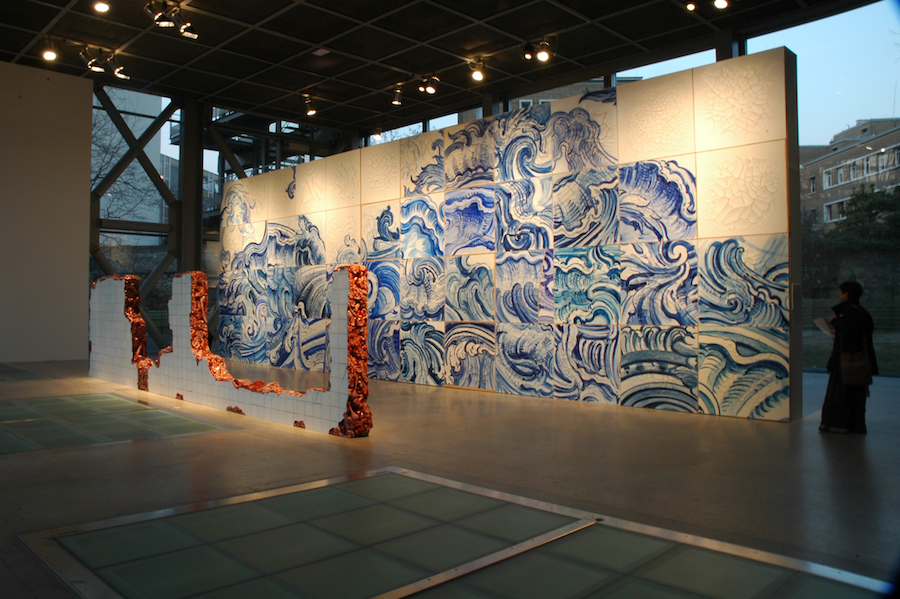
Installation view, Fondation Cartier, Paris. © Adriana Varejão. Photo by Vicente de Mello. Courtesy Gagosian Gallery.
In your series Tongue and incisions (walls with incisions through which entrails sprout out), the inorganic matter of the tiles is joined together with the organic matter of the viscera. Where does this need come from?
I wanted to combine the rational grid of the tiles with the erotic nature of meat, all simulated within the artificial and voluptuous language of the Baroque. The tiles are not tiles and the meat is not meat.
You convert the object into something transcendental when you add entrails, our most inner and private parts, only to later tear it up. What enigma hides behind these pieces?
It's to reveal a body behind the layers. When I am dealing with "history", I am dealing with history imprinted or inscribed on bodies, private, fluid, and individual -- which is very different from the official versions of world history.
That meat is like a violent explosion. Does it comprise any sort of love or sacrifice?
Yes. I am engaged with the history of art not reality. Painting meat and flesh belongs to a very, very old tradition in painting -- pintura de bodegon and the Baroque tradition that exposes the body through wounds, and for which the bleeding anatomical heart is the emblem. Think of Goya, Rembrandt, Gericault, Soutine, Bacon, and then, of course, Paul Thek, who worked in three dimensions with his modernist "reliquaries."
There is an Eastern penchant that is reflected in references to the great Wave of Kanagawa, landscapes and eroticism... What sort of interest do you have in this culture?
I am dealing with parody, not with real history. And in doing so, I am addressing the migration of images, from Portugal to Brazil via Asia, which you can find, for example, in the interior decoration of Baroque churches in Brazil.
Related to the Azueljao paintings, I also studied Chinese Song pottery of the eleventh century. I became deeply fascinated by its characteristic surface cracks and its attendant philosophy. It is in these cracks that Chinese writing actually originates. An entire aesthetic evolved from reading meaning into cracks, slowly becoming its own culture.
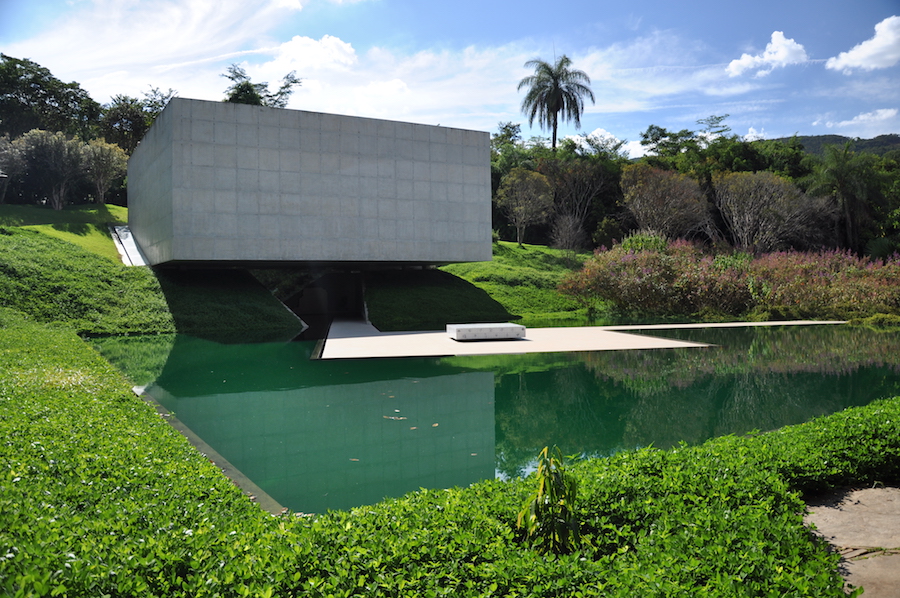
Adriana Varejão, Panacea Phantastica, 2003 – 2008, at Inhotim, Brazil
Please tell me about your installation at Inhotim in Belo Horizonte, Brazil, where all of the arts come together as a total work.
Much of my work is inspired by the traditional Portuguese azulejo, which were traditionally used to decorate architecture. My Inhotim project is a modern architectural cube that is penetrated by water, terraces, staircases. I made a container with an inner skin of tile paintings, sculptures that relate to architecture, and real tiles incorporated into built-in architectural furniture.
Thermal baths, pools, tiles and water. Once again, we see the organic and the inorganic in your iconography. Sometimes there are ripples of violence in your portrayal of water. In your work, what is the meaning of the connection between violence and water?
It is only fiction; the inference of violence gives some drama to these scenes. In the sauna paintings, I deal with very classical topics of painting -- paint, color, tone, perspective, and so on. They also reflect the erotic literature that I was reading at the time -- Georges Bataille and the Marquis de Sade. I gave these paintings titles like The Collector, The Seducer, and so on. There is an ambiguous atmosphere, a suspended narrative in these paintings. When I was working on them it was much more about painting than telling stories.
Some of your works display the prevalence of violence, the violation of limits, both sexual and in the form of the abuse of the body, sacrifice and death. What is behind this tendency for such extreme life situations?
To elaborate on what I said earlier, art is an experimental universe where everything can be played at the edge. That is the role of art. I explore violence in many forms in art, not in life. Just as de Sade attacked language not the body itself, acting symbolically.
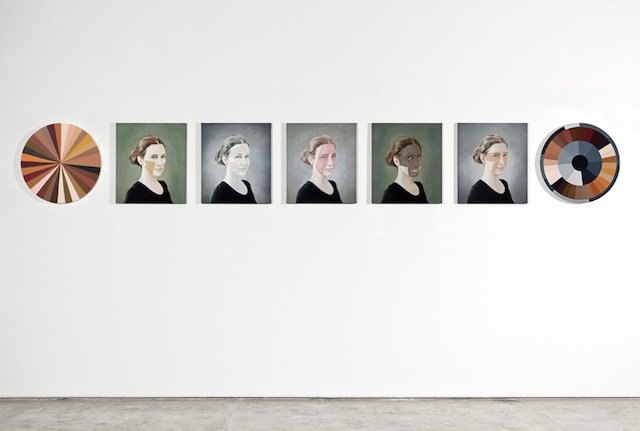
Adriana Varejão’s series Polvo. Image courtesy of ICA Boston
In your series Polvo –a set of self portraits-, the central focus actually resides in the changes in your skin colour. What message are you conveying about the racial and cultural identity of Brazil?
This is about the mestizo identity of Brazil, which is nothing to do with the polar opposites of black or white, but with all the many shades and subtleties and variations in between. Polvo is a paintbox where the names of the paints reveal that every definition is about language, like "Almost White." I started thinking about the idea of "flesh tone" and what it means in different cultures, but in the beginning I could only find a pink color in all of the oil-paint brands that I was collecting all over the world. So, I decide to develop a conceptual brand "Polvo", that reveals the complexity and variety of the subject. Color is a language subject.
And what is the relationship between identity and the portrayal of power and subjugation in your work?
I believe in miscegenation, not the dichotomy of master and slave. Brazil evolved as a country with a cultural (mestizo) identity that is so strong that it is impossible for any single identity to remain fixed, separate, and intact for more than one generation.
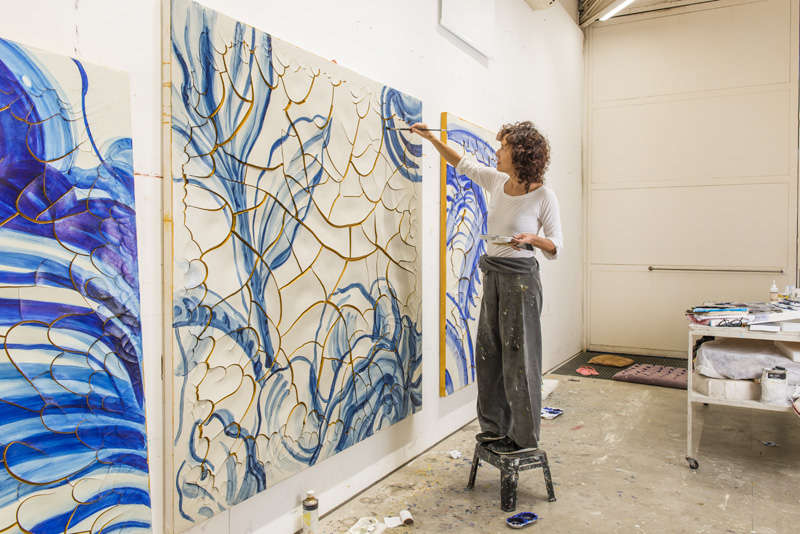
Portrait of © Adriana Varejão. Photo by Vicente de Mello. Courtesy Gagosian Gallery.
Adriana Varejão: “Azulejão” Until December 16, 2016
Gagosian Rome - Via Francesco Crispi 16, Rome
- Details
- Written by Elena Cué
Launched to fame by the Italian Trans-avantgarde in the early 1980s, the work of Francesco Clemente (Naples, 1952) follows an undetermined, enigmatic style that is in constant transformation and flow. The turning point that marked his career was his mystical journey to India in the 1970s, where he found spiritual reconciliation. Clemente had the wise intuition to settle in New York, where he has developed the core of his work. Much of Clemente’s pictorial production is figurative, through portraits whose ghostly atmosphere reveals a transcendental vision. It is this fusion of cultural roots where East meets West that gives him his most personal touch. From his studio in New York we will be exploring his life and his work.
Author: Elena Cué
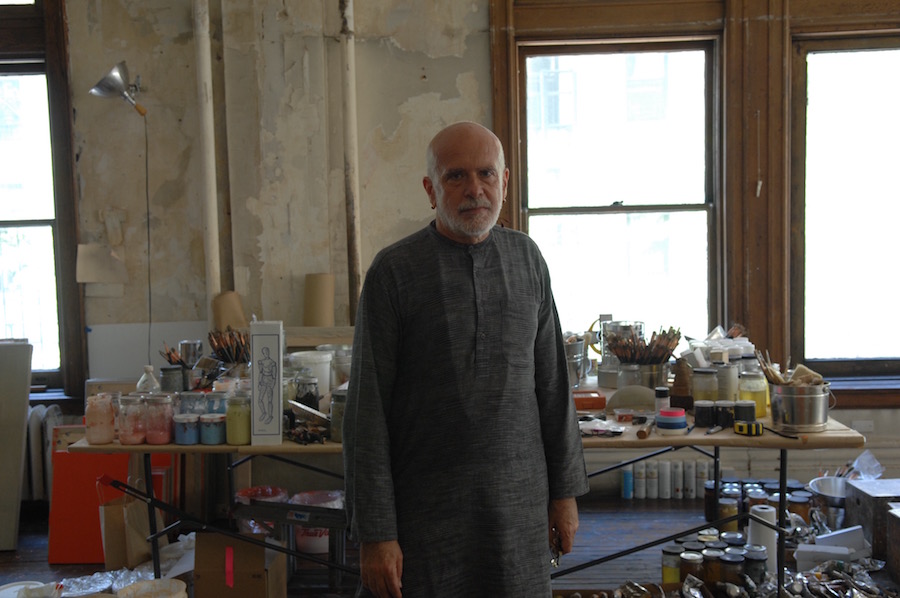
Launched to fame by the Italian Trans-avantgarde in the early 1980s, the work of Francesco Clemente (Naples, 1952) follows an undetermined, enigmatic style that is in constant transformation and flow. The turning point that marked his career was his mystical journey to India in the 1970s, where he found spiritual reconciliation. Clemente had the wise intuition to settle in New York, where he has developed the core of his work. Much of Clemente’s pictorial production is figurative, through portraits whose ghostly atmosphere reveals a transcendental vision. It is this fusion of cultural roots where East meets West that gives him his most personal touch.
From his studio in New York we will be exploring his life and his work.
I would like to start asking you about your youthfulness. What was your experience in Italy, bearing in mind all the political unrest at the start of your career, with the terrorism with the Red Brigades, the social conflict…?
If you say 60s, we are talking about my teen years and what comes to mind is boredom. I’m very lucky, because I lived at a time when you could be immensely bored. I think that without boredom, you can’t get any new ideas in your head. From that, we entered the 70s. Yes, my generation is the last Marxist generation. Also, the seventies was the last decade that produced ideas, and some of those ideas are still valuable to me. I’m a big fan of Debord’s book, The Society of the Spectacle. There is a flag here in the studio that shows a quote from the book, which is a prophetic book.
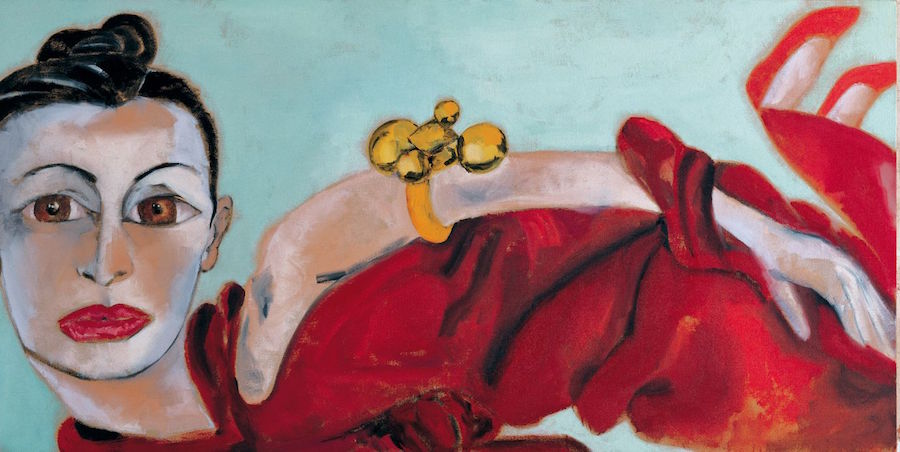
“Alba,” Francesco Clemente. Photo: Guggenheim Bilbao
And then, in the 70s you travelled with Boetti to Afghanistan and then to India….
I travelled to remote parts of Afghanistan with Boetti. We went all the way to Pamir, the crossroad between Pakistan, China and Russia. It’s the very tip of Afghanistan. It was an adventurous thing to do, but back then you could do that.
And you opened a studio in Madras. What were you searching for in India?
I felt that history had led me to a dead end. I didn’t see where I could go. So I decided that my work should draw from geography, rather than history. I didn’t know anything about India when I went there the first time.
What has interested you most of Hindu culture: the more sensual aspect with its chromatics, the corporeal aspect… or do you prefer the spiritual side?
That’s a Western dilemma: spirit against body. But even in the West, in the alchemic tradition, they say you should spiritualize matter and materialize spirit. So I was looking for reconciliation.
You have also worked with Hindu artists, and I have seen you continue work with them. What do you get out of the joint creation process?
Well, I believe that the most accurate description of our consciousness is continuity of discontinuity. So I indicate with my work the fact that we have a fragmented self and I’m interested in the gaps that separate all our different personas. Many of these ideas can be found in the contemporary traditions of the East. All of those traditions deal with this.
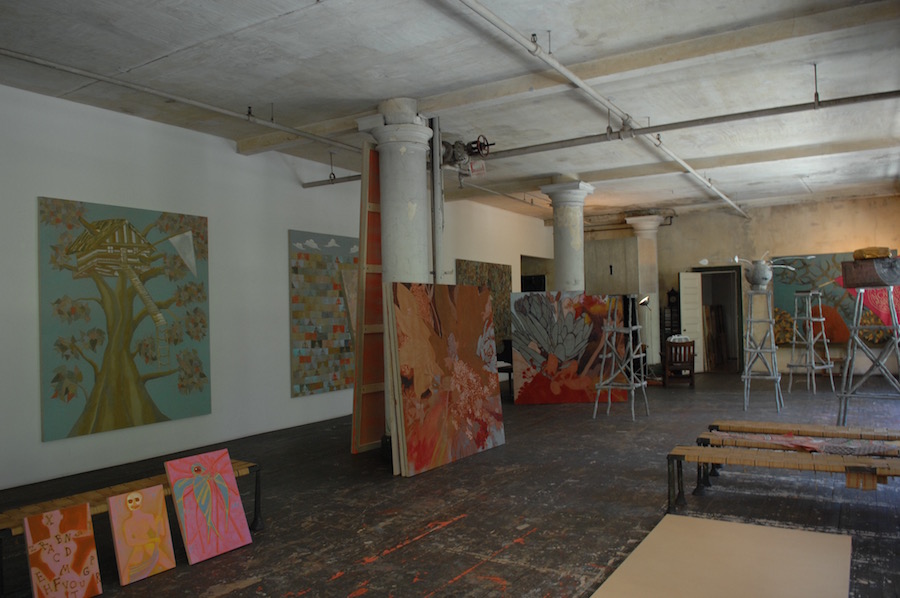
Estudio de Francisco Clemente en Nueva York. Foto: Elena Cué
You were one of the main figures of the transavantgarde movement of the 1980s, when painting was upheld once again as a reaction to immaterial avant-garde. How do you remember this change?
Well I think those few years were a window of liberty and adventure, which didn’t last very long. Today, we are confronted with an international style that is in a way very neutral and very academic, if you want. So again, I was very lucky to be in the right place at the right time.
What led you to subsequently split from this movement?
It wasn’t really a movement. I think, actually, that whole generation of artists lacked a proper theoretical background and no one really bothered with that. So there were a few labels, you know, the neo-expressionist, the transavantgarde… but all of these were only labels. It was more of a synchronicity of several people in different parts of the world going back to making art drawn from life and not from other art.
When you look at the paintings of that time, at the explosion of feelings and expression of desire, dreams and fantasy, do you recognise yourself?
I’m an empty chair... I don’t have a self to recognise.
What can you tell me about your collaboration with Basquiat and Warhol, two of the most representative artists of the New York scene of the 80s?
I think the reasons of the work are more important than the appearance of the work, so I’m very proud that we did these collaborations because they show that the intentions are stronger than the appearance. I mean on the surface, these three works are very different from one another, but somehow they are drawn together by all the things we didn’t like, rather than what we liked. I have fond memories because I personally liked both artists tremendously. I was very close to both of them. I miss them both. They could both be alive… it is still their time.
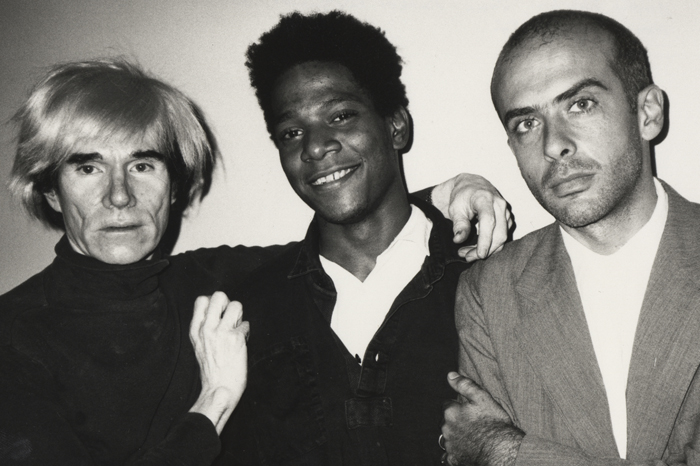
Andy Warhol, Jean-Michel Basquiat & Francesco Clemente photographed by Beth Phillips, 1984.
Is art enough to meet your spiritual need?
No, I pray every day. Art is a form of giving, not a form of receiving. You don’t receive from art… you give to art. But to give is also a need.
Which have been your main obsessions?
My obsessions are constantly renewing themselves. I move from one obsession to the next. But in my trade, obsession is not considered a disorder; it’s considered a necessity.
Most of your portraits are impenetrable. What do your faces speak of?
Eternal life, maybe.
And are you also impenetrable?
I’ve been told three times by very different people that I remind them of smoke. Is smoke impenetrable? I don’t know. Hard to catch, for sure.
There have been many changes throughout your artistic career, as well as in your techniques. What is the reason for so much movement, so much change?
It was my intention from the beginning to not anchor myself to a particular solution, or a particular style. At the same time, that is my strength because it means that everything I do is fresh, and my weakness because I am constantly beginning, which means that I never know what I am doing. Also, the goal of my work is to remind the viewer of the necessity to be fluid, to be in a constant state of transformation.
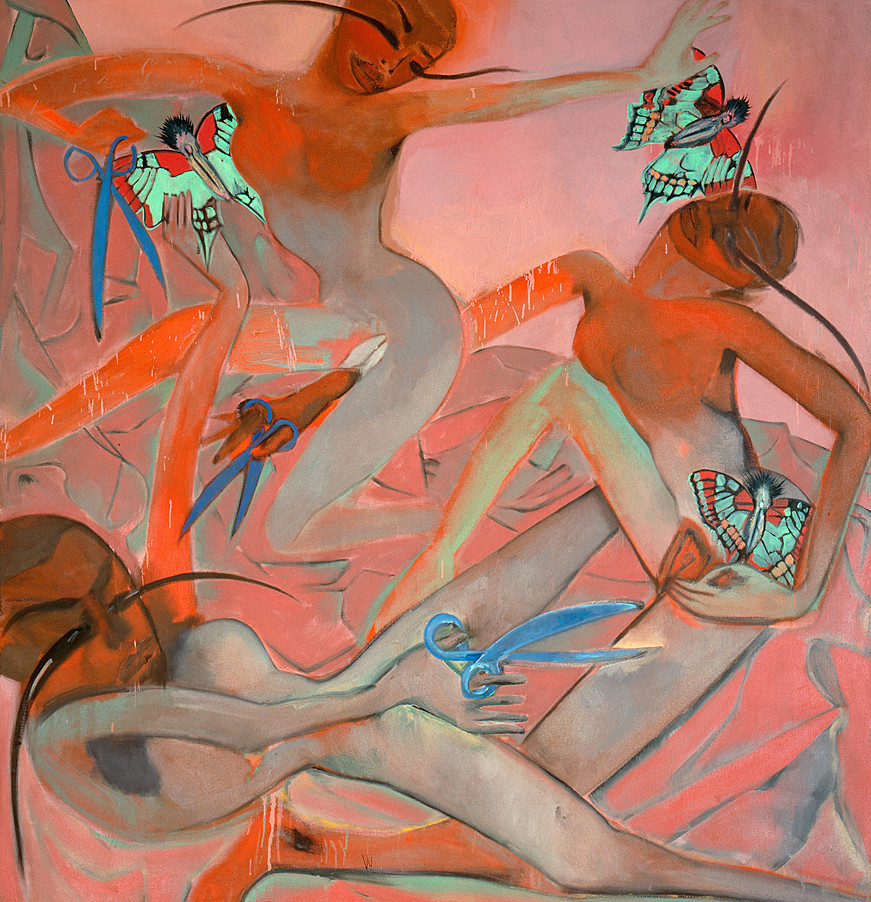
“Scissors and Butterflies,” Francesco Clemente. Photo: Guggenheim Bilbao
Your paintings are very enigmatic. What do they mean to you?
My paintings are enigmatic, life is enigmatic. Everything is an enigma, everything is a mystery. There’s a beautiful quote in a de Chirico painting that says in Latin: Et quid amabo nisi quod aenigma est? (And what shall I love, if not the enigma?)
Do you discover something about yourself during the process of making your paintings?
The advantage of making something by hand is that you never make what you intend to make, so then you have to adapt to the circumstances. So in that sense, you have to be open all the time, and upset, which is a good lesson for life.
Do you recognise the state that you were in at the time of painting?
Yes, my paintings are tied to the changes in my life and they’re tied to a sense of synchronicity. I’m a believer in synchronicity. You know, the simplest example of synchronicity is when you think of someone and then you turn the corner and you see that person. I am very much in touch with that kind of resonance and symmetry in life, where things don’t happen on their own, they happen in clusters. They all bounce against each other. I’m a listener… I listen to the harmony of life and I translate that in my paintings.
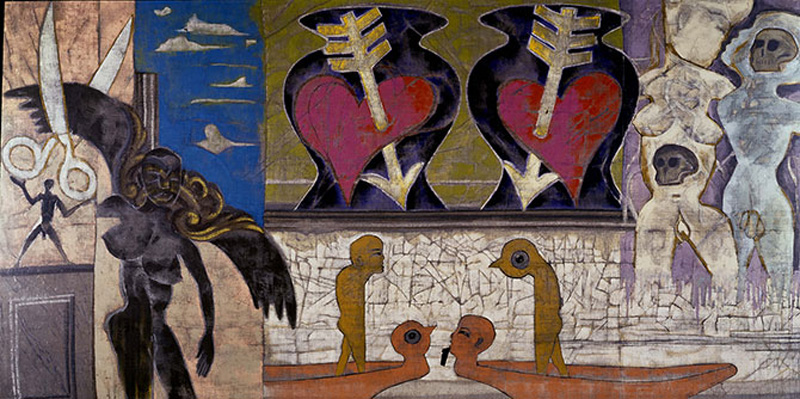
“Iniziazione, La Stanza della Madre / Initiation, Mother’s Room,” Francesco Clemente. Photo: Guggenheim Bilbao
Isn’t your painting a sonata of specters?
Yes, I definitely feel like a ghost a lot of the time. I wouldn’t want to feel too real.
You, who were born and trained in Italy, who has lived an intense experience in India and who now lives in New York, how do you relate with your identity? Who are you, from among these three strong identities?
The aim is to not be a prisoner of any of these identities. The space I really want to inhabit is the space in between all of these identities. From each place I want to remember and long for the other one. I don’t want to belong anywhere, really.
Do you need to find inspiration whilst travelling, or is it something you do not seek? Perhaps it is like Picasso said, that inspiration has to find you working?
One thing leads to another. The only obstacle in life is ourselves. If you remove yourself from the picture, there is really nothing you can do.
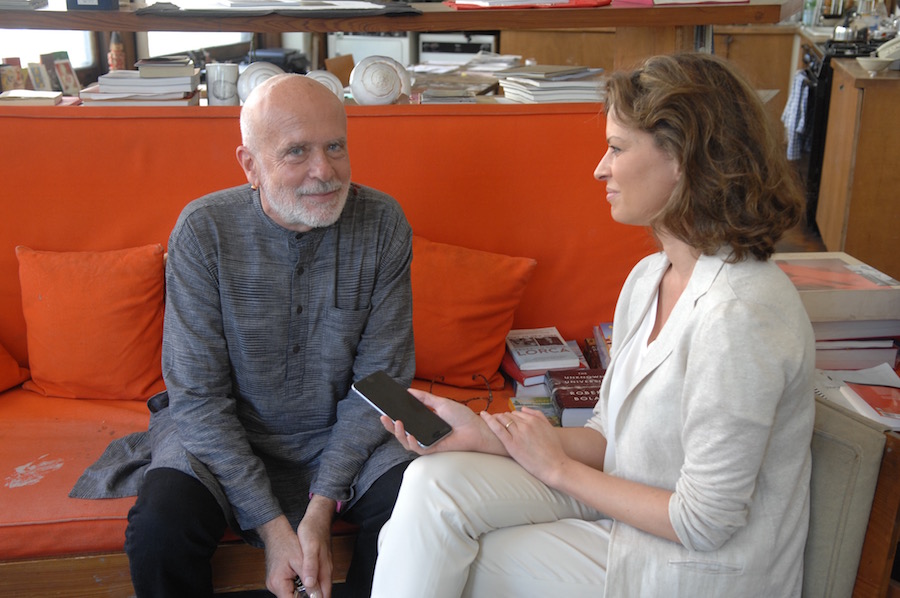
- Interview with Francesco Clemente - - Alejandra de Argos -
- Details
- Written by Elena Cué
The art of Lita Cabellut (Barcelona, 1961) is pure feeling, like the haunting voice of flamenco singer Camarón de la Isla whom she so greatly admires. The colossal format of her paintings and subjects, whom she endows with great psychological potency, are the clamor of an artist who needs her voice to be heard. Her work exudes the wisdom of life that runs through her gypsy veins. She portrays souls with expressionist strokes that spring from forces underlying all thought. Their gaze is by turns defiant, nostalgic, beseeching, proud, sensual, wise… Every portrait tells stories: the stories of the artist, our own, and universal stories of the human condition. Gaze, gesture, and skin convey the scars of life’s wounds but also all its beauty. A constant dichotomy exists in her life and work: the formal and the wild, light and dark, reason and passion, but always there is beauty.
Author: Elena Cué
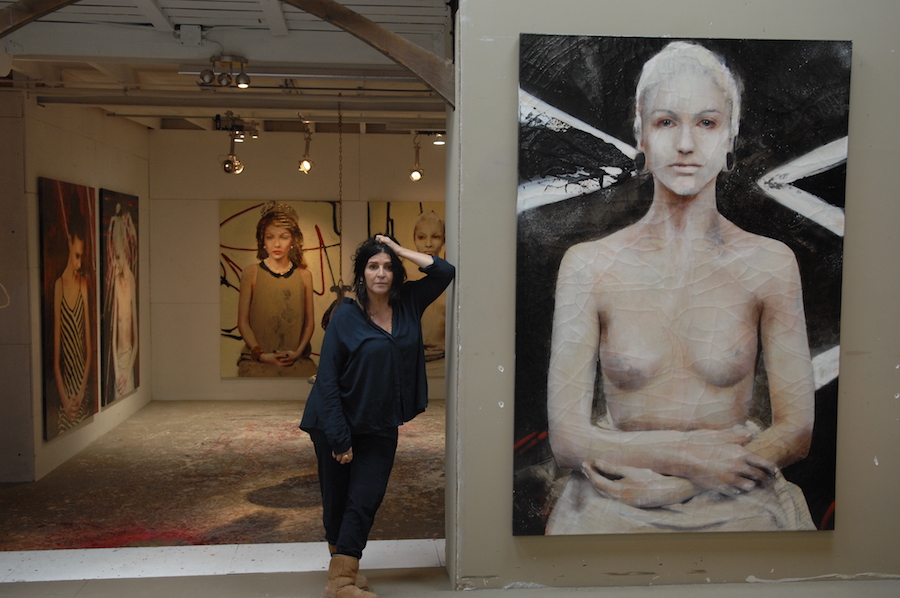
Lita Cabellut. Photo: Elena Cué
The art of Lita Cabellut (Barcelona, 1961) is pure feeling, like the haunting voice of flamenco singer Camarón de la Isla whom she so greatly admires. The colossal format of her paintings and subjects, whom she endows with great psychological potency, are the clamor of an artist who needs her voice to be heard. Her work exudes the wisdom of life that runs through her gypsy veins. She portrays souls with expressionist strokes that spring from forces underlying all thought. Their gaze is by turns defiant, nostalgic, beseeching, proud, sensual, wise… Every portrait tells stories: the stories of the artist, our own, and universal stories of the human condition. Gaze, gesture, and skin convey the scars of life’s wounds but also all its beauty. A constant dichotomy exists in her life and work: the formal and the wild, light and dark, reason and passion, but always there is beauty.
We begin our conversation in her studio and home in The Hague.
Elena Cué: You were abandoned by your mother just months after you were born, taken in by your grandmother and lived on the streets of Barcelona until you were adopted at age thirteen. You knew you wanted to be an artist at that age, when your adoptive family took you to the Museo del Prado for the first time. In your earlier life, before you began to paint, how did you channel your artist’s energy?
Lita Cabellut: Through fantasy, I think. You aren´t aware of what you are living or doing at the time. But what I do remember is that I was a ghost: I sold stars, for example. Now I think about it, and the artist was already present. Though of course, talent that isn´t developed doesn´t grow.
What do you think art is about?
It’s a way of conceiving, seeing and feeling about life. Art is much more than material. It is a great empathy for the world, for life. That is what art really is, because much of it is ethics, and fundamentalisms. It’s unavoidable: freedom and dictatorship at the same time, life and death. It’s so complicated and so simple at the same time. We always want to idealize art, isolate it, and make it individual.
Which it isn’t.
Which it isn’t, and that’s why art is suffering right now. We’re determined to isolate it and make it individualistic. Plato said that beauty was love materialized. I think that´s sort of it. Art absorbs, because it is a constant death and rebirth in the same day. You have to give it everything, and that’s why there’s a lot of risk in my work. The line between good and excellent is so fine, and that excellent has a risk. Not to be better, but to overcome what you don´t know. When we love and cherish what we don´t know, that´s when we start to understand what art is. Because art is ugliness as well, and it is beauty, and hardness. Art is velvet on the outside and bleach on the inside, because it burns you.
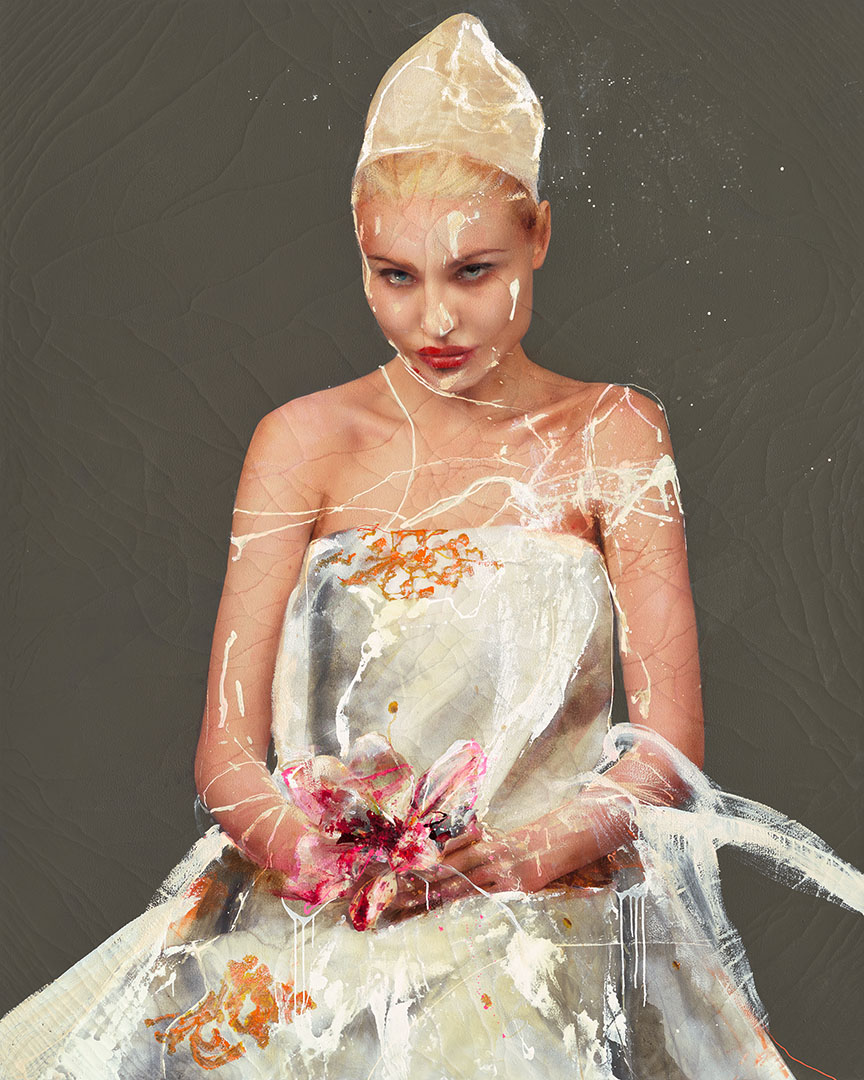
Lita cabellut. Impulse. Courtesy of the artist's studio.
Why did you choose figurative painting as a means of expression and focus on portraiture?
It´s an obsession. In reality, my great passion has always been psychology. When I was a small child I was already aware that by studying people you could prevent calamities. I knew very well what my next three hours were going to be, what the situation might or might not be. And then that turned into a form of survival, and then a way of living. What interests me most are human beings, because humans are so complex, so beautiful and ugly at the same time, so much so that it is fascinating. So I began to pay attention to figurative artists, and then I switched over completely to Saura, Tàpies and abstract artists. And you can see it in my work. It’s a communion of figuration and abstraction.
What is the importance of abstraction to you?
Abstraction is very important to me. I went back to the museums, to study Velázquez, Goya... I realized that they were the great abstract artists, and that they used it as a means for illusion to give form to a figuration that did not exist. That´s when I began to see abstraction as interesting, from that philosophical point of view. The great masters use figuration as an illusion of something that doesn´t exist and that our brain finishes. For example, if you look closely at a clothing in Velázquez, with its cuffs and fabrics, it’s totally abstraction. It´s an illusion of what you are seeing. It is points of light, of matter, placed in such a chaotic and anarchical way that from a distance they form an image that forces you to see. So if the artist has the power to manipulate the eye of the person who is seeing, and takes the eye to another place where it would not normally see, that’s art. That seemed very interesting to me, and I began to use figuration much more. At first without faces, just bodies. Because I wanted to study position for people to see gesture.
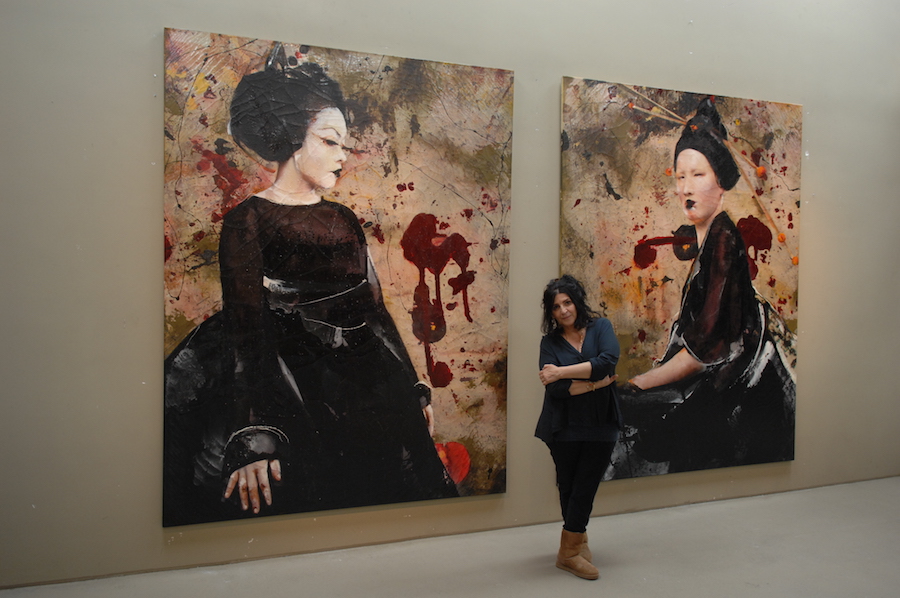
Lita Cabellut. Photo: Elena Cué
How do you choose your subjects?
They´re models. But first is the theme. I always work by themes.
And how do these themes come up?
For example, the trilogy of doubt came to me one night when I was talking with a friend who told me that she was having a legal problem. And I thought, there is so much doubt in knowing who is right, and truth is so difficult to find. And suddenly the title came to me: the trilogy of doubt. It will be about power, impotence and ignorance. Because through ignorance, tremendous things are done.
And in what way are you in each one of these portraits?
All portraits are great self-portraits. They are a way to relive distant, hidden, present and latent emotions every time. Every portrait is me. In the trilogy of doubt, where there is the great dictator, a victim and an ignorant, I’m all three. When I paint, I am in the painting. It´s me. You know what happens? You can only paint or create what you know. Empathy happens because we recognize ourselves in something. We cannot feel something we don´t know. It´s impossible, just an illusion.
Is art a cure or a palliative?
It´s difficult for me to imagine life without art. It´s as if God had turned out the lights of the world. The sadness I feel at living without art is so deep that it makes me dizzy. Art has cured me a lot. I am a happy woman, so to speak, of course. But I am a woman who lives, and I love life, and my children, and I love who I am and what I am not. I see possibility in everything. I owe all that to the possibility of dying every day and being reborn: I’ve been able to do away with so many things that weren´t good for me, so many emotions, and give that form in these images.
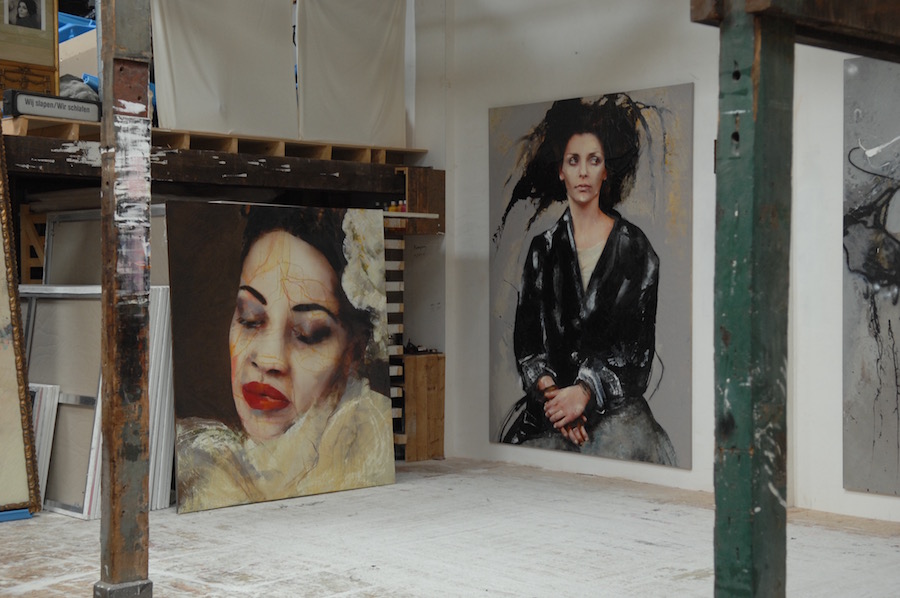
Lita Cabellut's studio. Photo: Elena Cué
Has art helped you forget or remember?
I’d say acknowledge. Provide a place. Listen, for example I painted monsters, images that were monstrous. I painted everything that frightened me and was still in my subconscious, and would suddenly appear like a capricious dog that sits in an unexpected spot. Feelings and images would come to me that I didn´t know what to do with. These days I don´t title my works, though I used to, because I wanted to identify them, I wanted to see all of those feelings. And it´s really interesting, because once you give those names and see them, they become very small. The more intelligent you are, the more fears you have. For children, who dream about that, it´s a kind of active intelligence. There is so much risk in the world, so many dangers, that intelligence needs to calculate those dangers in order to survive. It´s the law of the strong. I´ve always had many fears, like not being able to sleep with the lights off. Now I sleep with the lights off in the house, but not in the garden.
In other words, you’ve been getting rid of those demons through art, by giving them form and getting them out of your unconscious…
Exactly. I´ve been able to paint it all: ugliness, cruelty, tenderness, all of those elements… You have to think that you´re like an octopus, with tentacles that need to touch all kinds of emotions. If you are unlucky, some of those tentacles will be stunted, because they haven´t been able to recover or have not had the right space. I´ve been able to use them extensively in my own work. I´m certain that are has cured me. I have a foundation for children so there can be art. Because I´m absolutely sure that art goes much further than psychiatric methods. These are necessary as well, but art goes much further.
Art... and love?
I remember when I was small how difficult not feeling loved was. It was really tough. I’m a mother and I know what that is. No one can imagine how important the love of family is for so many things to grow. It´s true that tragedy, for artists, is like a box of jewels. You can´t paint suffering or pain if you haven´t lived it. It will always be an imitation, a caricature.
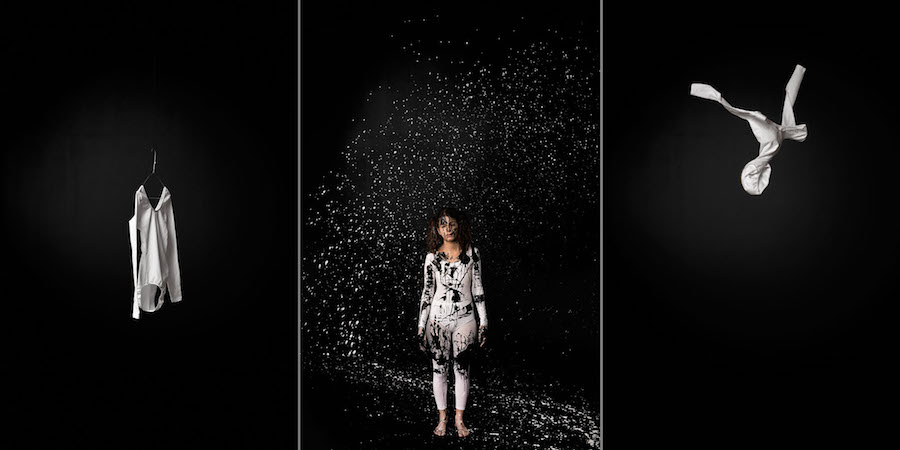
Lita Cabellut. Silence of the white. Courtesy of the artist's studio
Do your paintings tell your story?
In reality, they are all my stories. For example, Impulse is a series about the ultimatum of female beauty. You see how I threw puddles of paint on those paintings; they are really violent attacks. Impulse is always an act of violence, but an act of violence is also an act of love. I´ve lived a lot of violence, I´ve seen a lot of female violence. For me, it´s also a way of dealing with this topic, and of letting it go. It´s not that I am trying, through my work, to better the world, but that I simply try to show the world that these aspects must be considered, must be seen, named and above all given a voice.
Everything about you is learning and overcoming.
That is what I always try for. Elena, in everything that is ugly, you have to find that spot of beauty. Because it´s there, it´s always there, in the most horrible things that happen to you. I always say: if you haven’t walked on the carpet of sorrows, you can´t kiss life. It´s important, so you can know what you love and what you don´t. Imagine getting to the end of life, at an old age, and regretting everything we haven´t done, because we didn´t want to get into trouble, we didn’t want to commit or suffer too much. Can you imagine that?
Courage, that great virtue.
Courage is an act of responsibility. It´s so important, it allows you to change things, to move forward. What frightens us most is to be responsible for our actions. If you are brave, it means you accept that things can go wrong. Do you know how beautiful it is to accept that things might go bad? That´s freedom. Courage is freedom.
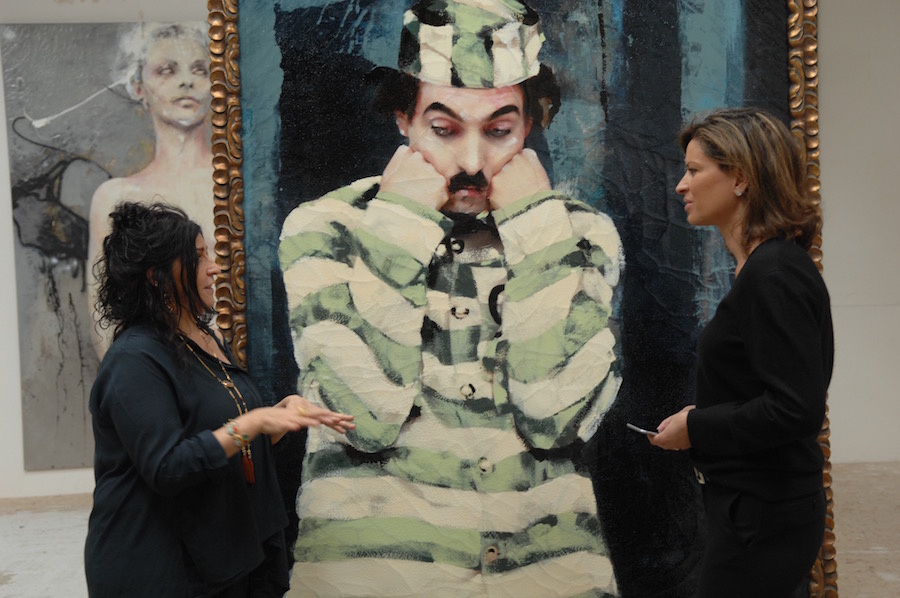
Lita Cabellut and Elena Cué during the interview. Photo: Elena Cué
- Interview with Lita Cabellut - - Página principal: Alejandra de Argos -
- Details
- Written by Elena Cué
Jean-Luc Nancy (Bordeaux, 1940) is one of the foremost French thinkers of our time. For many years, he was Professor at the Université Marc Bloch in Strasbourg. His Christian background, present in his beginnings, evolved with his discovery of Heidegger’s philosophy. Another decisive influence was his discovery of Structuralism and his contact with Derrida, which among other things served to strengthen his preference for the contemporary in his philosophical reflections. We began by talking about the challenges that philosophers face nowadays. What would you say are the greatest challenges that philosophical thought faces today? In philosophy, nothing is a given. No meaning can be considered obvious.
Author: Elena Cué
Jean-Luc Nancy. Foto: Aïcha Messina
Jean-Luc Nancy (Bordeaux, 1940) is one of the foremost French thinkers of our time. For many years, he was Professor at the Université Marc Bloch in Strasbourg. His Christian background, present in his beginnings, evolved with his discovery of Heidegger’s philosophy. Another decisive influence was his discovery of Structuralism and his contact with Derrida, which among other things served to strengthen his preference for the contemporary in his philosophical reflections. We began by talking about the challenges that philosophers face nowadays.
What would you say are the greatest challenges that philosophical thought faces today?
In philosophy, nothing is a given. No meaning can be considered obvious. For example, it isn’t possible to talk about “man”, “society” or “science” as if these words designate well-identified realities. The challenge is precisely not to latch on to any acquired identity. For a philosopher, nothing should be taken for granted. Preconceived and established meanings must be constantly reevaluated, and new possibilities opened.
How can a philosopher teach a society to think this way when it is as anxious as ours is for answers and truths that it can cling to?
It is precisely this impatience that can be a trap. In one sense, impatience is right: there is no reason to wait, and the conditions for a decent life can be demanded at any time. On the other hand, there are obscure and complex questions to which emphatic or “radical” answers, as we like to say, can be dangerous. The recent Brexit is a good example: the vote has just taken place, and its supporters have already become nervous and begun to question it. Or Podemos, which started off very strong but has quickly lost strength instead of gaining it. Furthermore, the current complexity is the result of opposing “impatiences”: the one felt by those who are excluded and the impatience of those who fear exclusion (the middle class); the impatience of people seeking refuge and the impatience of those who fear being overrun by refugees; and the impatience of those who miss how things were in the past vis-à-vis those who want to accelerate the arrival of the future.
At present it’s much more difficult to set a course than it was at the time of the workers’ struggles or the end of dictatorships. How did Franco’s dictatorship last so long when many people were against it? Because it was a time of societal transformation and transformation of the European economies, and in turn these transformed the conditions that would prepare the end of the dictatorship. Why are the European Socialisms and Communisms in crisis? Because their motors are too old. We have to find new ways for a new state of affairs in which techniques, powers and expectations have transformed slowly. And in fact, this is what needs to be made understood: a patience that is active rather than passive. An impatient patience and a patient impatience.
You have written often about terrorism, especially after the grave attacks in France. What is your opinion on this subject?
This terrorism is the combined effect of two forces: that of the change in Western dominance and of the assertion of Islam, which has seen its equilibrium destroyed by colonization and the end of the Ottoman Empire. This terrorism reveals an extreme situation created by the very strong contradiction between the Western model of development and wellbeing, and the reality of existence in countries that feel marginalized, and where the upper classes or casts preserve the enormous differences in terms of wealth and status.
At the same time, the West is weak in its own strength. It doesn’t believe in its own civilization any more, it is preoccupied with its own technique and sees how capitalism grows without lessening differences in standards of living, while no Socialist economy has been able to last long (the Soviet economy was a State capitalism). In fact, there is no “West” anymore, and instead there are techno-economic poles of power whose visible heads are the United States of America and the Non-United States of Asia, but whose possessions and actions are found almost everywhere, and wherever there are resources to be exploited. Europe no longer has a consistency of its own, and it is subjected to this division of world powers.
And globalization...
Therefore globalization provokes explosions, tragedies and social and cultural collapses of all kinds. For five centuries we believed that utopias were achievable, and we have believed in their vanity. Now we have to think differently, and reflect on our place in the world. This will take a very long time… centuries, forcibly… But societies have always shown that they are able to overcome considerable challenges.
What are you referring to when you talk about the “surprise of liberty” Do you believe that we are free, or not?
Liberty is not a faculty we possess, or a right that we have at our disposal. Liberty resides in the fact that our existence is not programmed, and must find its own path. However, it has to do so as existence in a world that has conditions and limits. We are not free if that means “to be able to do what one wants” and “be independent of everything” because we depend on a lot of things, and most times our “will” consists only of propensities, hopes and yearnings that come from somewhere else. Understanding this and what that means is the beginning of liberation. And that is why liberty surprises us, because we discover that there is something other than what we thought was obvious.
For example: I become ill and cannot do my job, but I can see my state as an experience; the experience of not being in charge of all of my decisions, or of my preferences. Sometimes the ailing “give lessons” to those who are in good health.
Could you explain how suffering is an opportunity to broaden liberty?
That’s not what I am saying… and above all I’m not saying that it is an “opportunity”. Suffering is not a favorable occasion, it’s a reason to rebel, and especially to look for how to rebel, in the best of cases. In other words, to what end? Surely the aim is to not suffer more, but even that must be defined. For a long time, that goal was grounded in the word “Communism” or “Socialism”. But these concepts were never truly developed, except for in the Soviet form, and that form failed.
Why did it fail?
That analysis has not been done yet, or not sufficiently. Instead of looking deeper into that question, communists are happy to just deplore the dirty capitalism that has supplanted any idea of a fair society with that of consumer freedom. They complain about injustice, but they don´t know where justice is found. For example, we often hear talk today about a universal minimum wage. It seems like a fair and good idea, but it is also a very dangerous idea that would contribute to keeping many people at that minimum. The truth is that nowadays, in order to invent, first we must think. And we must scream as well. Brexit was an outcry by those who have been treated with contempt by the ruling class in Europe. We have to listen to that outcry. But what should we understand from it? That is what remains to be seen.
In your book The Deconstruction of Christianity, you talk about religion in today’s world. Could you tell me a bit more about that?
It isn´t about breaking, or annihilating, but about taking apart or de-structuring an edifice to show what it is made of. Now, Christianity is not made of religion. It was made from a profound mutation of Mediterranean humanity when it needed to emerge from the Ancient World, a world of limits, a finite world, and what we could even call de-finition. Everywhere there were gods with precise functions, rules to comply with, models to imitate and fixed horizons. At some point, that all crumbled. Undoubtedly, with the Roman Empire we saw the first “globalization” – when there was a departure from closed territories and fixed conditions (such as “free man vs. slave”). So then a desire for the infinite, and the promise of infinity began. This attainment produced a change in civilization, culture and society gave rise to the great adventures of the modern world, with all of their risks.
And with this deconstruction of Christianity, what specific conclusions have you come to?
The first conclusion is the most important: the profound transformation of the culture that occurred with the arrival of Christianity was the departure from religion as idolatry, as superstition, towards a cosmo-vision with an infinite horizon. The universal, the “whole” of Christian catholicity means, above all, the unlimited: no more idols, and instead an open infinity. So there is also energy for enterprise: we can and we must transform ourselves, and transform the world, infinitely. Christianity has materialized itself as humanism, as capitalism and as technical progress. This all becomes problematic and obscure, but we are always looking towards infinity. And religion as a collective point of reference has disappeared from the West.
The second conclusion is just the opposite: if Christianity took on the imposing religious form that it has had for centuries, it is because the certainties and references on which it is based are always desirable and highly desired. Then there are those who appropriate these references to construct meaning, as an instrument of power, an ideal of beauty or of the gratification of thought, and those who (and strangely, they are sometimes the same) seek representations, images and legends they can deliver themselves to. Atheism is unable to resolve many doubts. And that’s a shame, because religion as assurance is a lack of liberty, except for mystics and great spiritual men who have, on the other hand, helped many religions evolve as well.
To end, let’s talk about art. In what ways do you think that the meaning of “contemporary art” is different from traditional art?
Traditional art was linked to the possibility of the representation of truth – a religious, political or heroic truth, or a truth of perception, sensation or feeling. The modern world sees truth as an infinite process of searching. There aren´t stable and accessible figures or forms anymore, not even in what art has been able to produces in terms of forms we call abstract or colors without precise forms (Rothko, Newman, Pollock). A whole culture is being invented where the very meaning of “art” is becoming more obscure, precisely because it is no longer about representing given truths.
What would it mean?
The meaning of “art” is, in a way, necessarily enigmatic and elusive, because it does not allow itself to be formulated by language. Think about music: with twelve-tone music, serial music, electronica, jazz, rock and mixes of tonal and atonal music, our panorama of sound has changed considerably (as has our visual landscape, but sound has a stronger sensual penetration; think of electrification, techno, rap, slam, etc.). We look for new sensibilities, and that has its risks, of course. We search for what sensibilities and what enigmas of the senses are becoming “ours”.
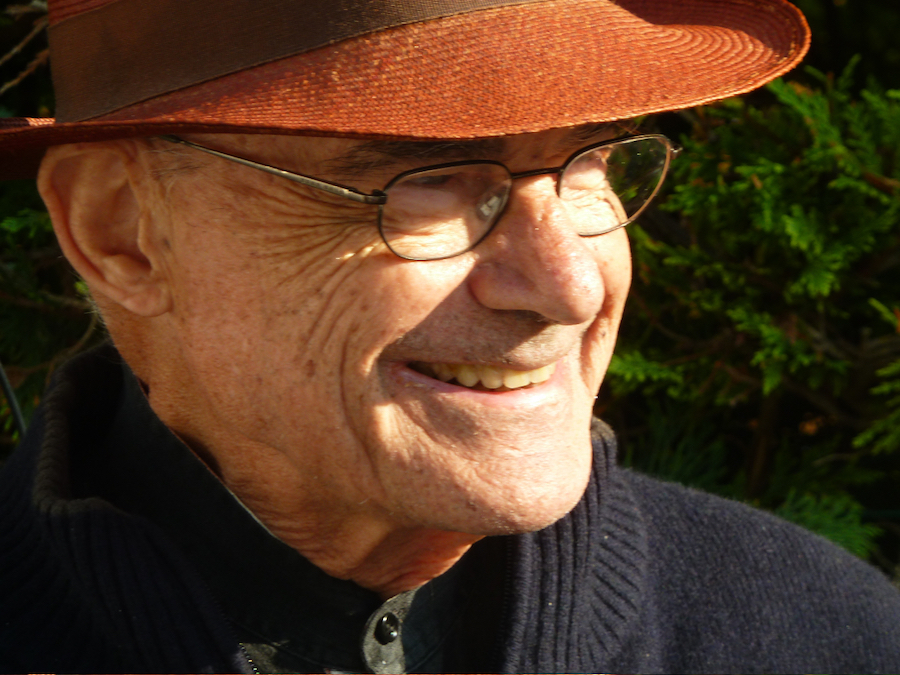
Foto: Jean-Pierre Daumard
- Interview with Jean-Luc Nancy: The West is no more - - Alejandra de Argos -
- Details
- Written by Elena Cué
British artist Jenny Saville (1970), one of the Young British Artists, deconstructs the stereotypes of beauty and eroticism of the female body as seen through art and through men, and then broadens them. She experiments with obese women and changes in the body, but above all she uses her own body as a model and means of reflection. She reveals the natural beauty of the individuality of the women she paints, and her own. Through the body, she expresses states of sensibility that bind us to our existence: uneasy, anguished, painful fleshiness… This defines her artistic language as much as her traditional pictorial technique. Figures are the sole focus of attention of her huge canvasses, which often cannot contain the whole figure in the same way that our selves cannot control our bodies. Her painting and her skill at drawing spawn a multiplicity of realities that build movement.
Author: Elena Cué
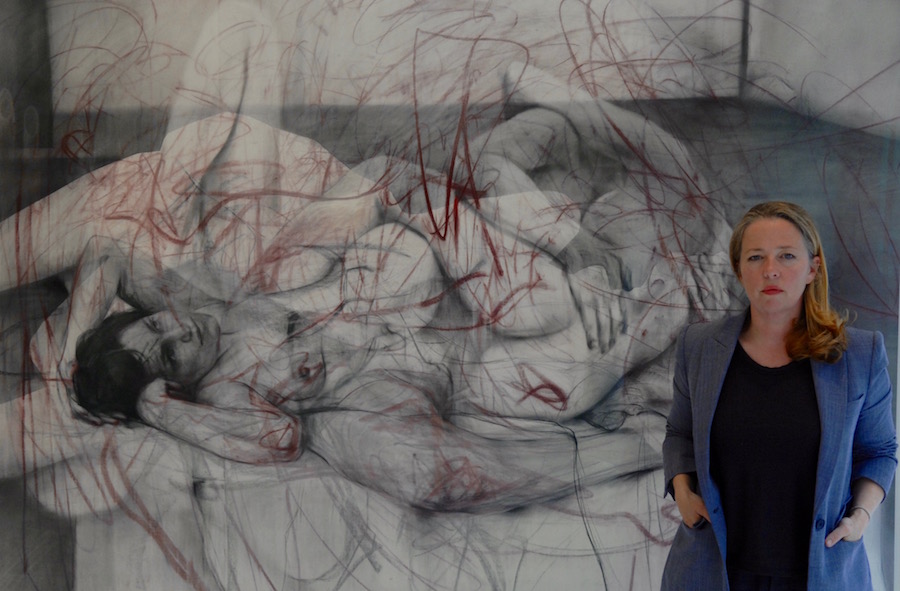
Jenny Saville. Photo: Elena Cué
British artist Jenny Saville (1970), one of the Young British Artists, deconstructs the stereotypes of beauty and eroticism of the female body as seen through art and through men, and then broadens them. She experiments with obese women and changes in the body, but above all she uses her own body as a model and means of reflection. She reveals the natural beauty of the individuality of the women she paints, and her own. Through the body, she expresses states of sensibility that bind us to our existence: uneasy, anguished, painful fleshiness… This defines her artistic language as much as her traditional pictorial technique. Figures are the sole focus of attention of her huge canvasses, which often cannot contain the whole figure in the same way that our selves cannot control our bodies. Her painting and her skill at drawing spawn a multiplicity of realities that build movement.
We begin our conversation in London surrounded by her latest drawings.
Your bodies experience anxiety, strangeness, sorrow... Do you recognize yourself in your multiple representations?
I think you are in everything that you make, to be honest. But I like to include everything, even to show sadness and violence. I want to encompass the whole world when I make art, I don’t want to exclude anything. The best work I’ve ever made has been through my instinct. When I try to be too clever or too analytical, it doesn’t work. I don’t ask myself too many questions during the making of the work because I follow my instinct. It holds a truth which is greater than the truth that I’m trying to get at through over-analyzing something. That was a lesson to me quite early on – that there’s something within that truth; that there are truths greater than knowledge. And if there’s a knowledge, sometimes you have to let go and follow your instinct to get to that greater truth. If you over-analyze or over-critique something, there’s almost no point in doing it. There’s no risk involved. I like the risk and the change and the transformation that’s possible in the making, and for me, that gets you to a greater art. It’s beyond reason. That’s what you’re trying to get… truth beyond reason. Because if you could write it down or you could speak about it, you wouldn’t need to make it.
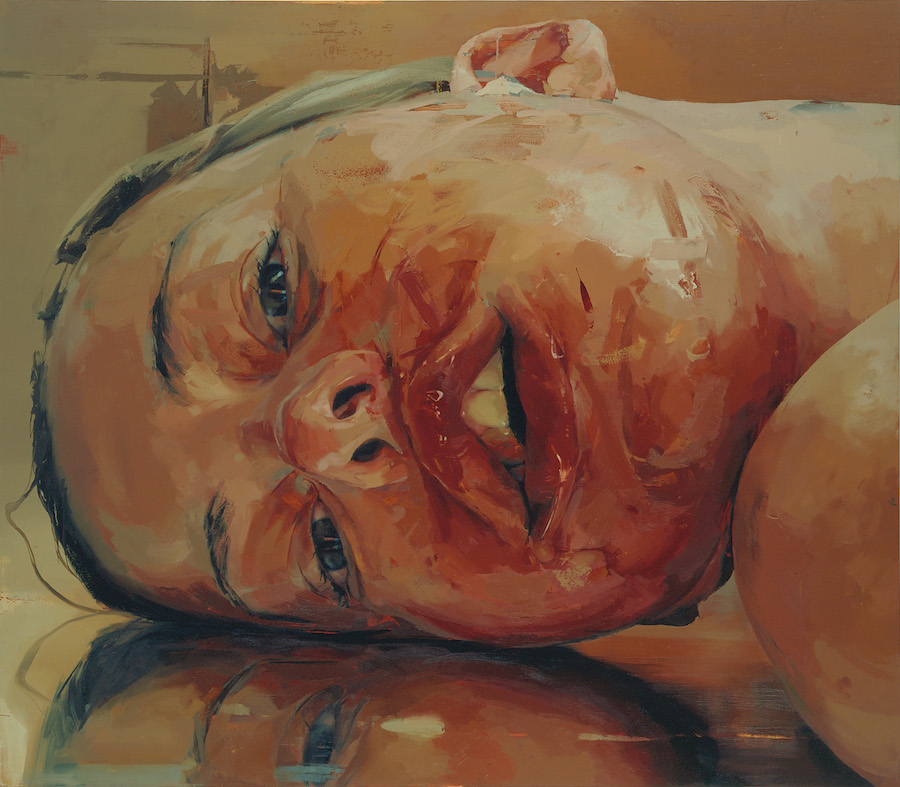
Jenny Saville. Reverse, 2002 - 2003. Oil on canvas.© Jenny Saville. Courtesy the artist and Gagosian Gallery.
The figures in your drawings overlap as a plurality of identities. Your face is present in most of your portraits. Is identity an important subject for you?
It’s not really my identity… I lend my body to myself, that’s the way I’ve always looked at it. But sometimes people aren’t prepared to put themselves into as painful a position as my body is prepared to be in. I’ve been conscious - since I was very young - that one day I’m going to be under the ground, I’m going to be dust, I’m going to be nothing. So what’s the risk? There’s no real risk. What could it be? Judgment? That I have a different body? That I don’t have an ugly body? I don’t care about that. I care about trying to use my capacity as a human. How far can I go as a human to make something that’s interesting? It’s not really about whether it’s my identity or not. It’s about a human identity. If you look at the Velázquez dwarf paintings, there’s an identity that goes across all of humanity. Or a great Rembrandt portrait – it covers everybody. I’m not an old woman in a Rembrandt painting; I don’t know what it’s like to be a seventy year old woman, but I feel the humanity when I look at that painting, so that’s the way I’ve looked at it.
If my body can offer me the ability to get to something interesting, then I use my own body. If I can’t, then I work with somebody else. So it’s not about this endless self portrait, it’s just that I’m available and it’s the ability to use my body to say something or to get to the emotion that I’m trying to get at in the work.
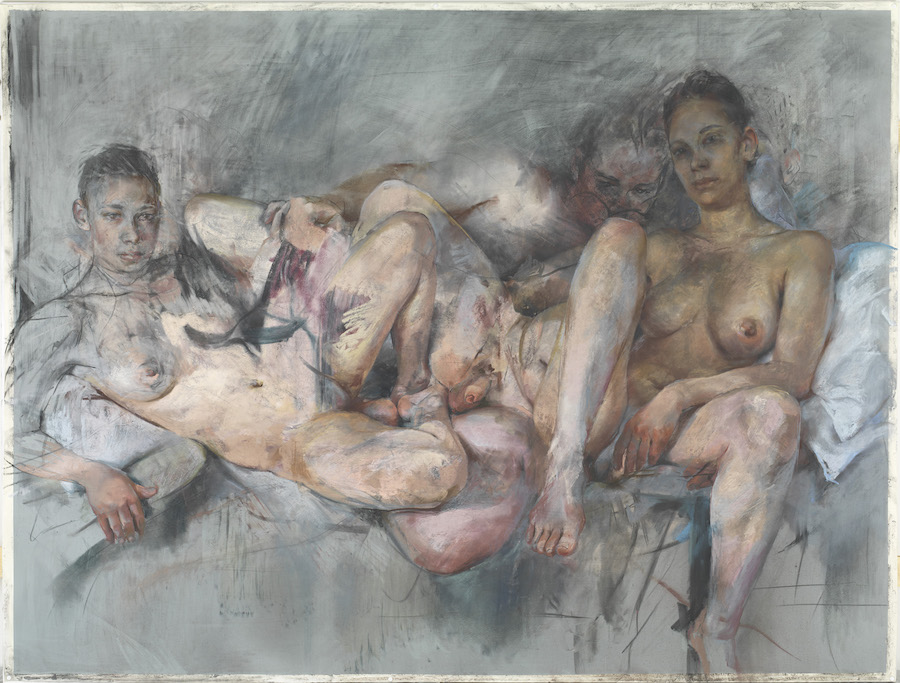
Jenny Saville. Compass, 2013. Charcoal and pastel on paper on board. Photo: Steven Russell.
Where does your interest or fascination for imperfect, violated, wounded or operated on bodies come from?
I don’t really know. It’s something I’ve had since I was a child. If someone fell over, I wanted to see what had happened. It’s curiosity; I just have a curiosity for that. It’s also an aesthetic interest. I mean, I’m not so interested in a kind of surface beauty, I think there’s a certain humility to getting underneath the surface of something or being prepared to show the reality of something. There’s a humility involved in it that I find in the work that I like. If you look at ancient Greek theatre or Greek tragedy, and you’re harrowed by the emotions on stage and the extreme violence, somehow that gives you a humility in who you are as a human being in the face of gods, or in the face of the universe. You’re so small and nothing. I think that’s the drive, because that’s the kind of art I like across the board – whether it’s in film or music – it’s the art that touches that part of us.
You spoke earlier about the influence that clasical artists from the past have had on your work. There is also a carnal tradition on Western painting. What is your opinion on art from other eras?
I’ve naturally always looked at older art. Especially because if you paint the figure when you’re young and you’re trying to learn, you’re going to look at figurative painting. So I learned by looking at Titian, Velázquez, Rembrandt, Leonardo, Michelangelo… I was very lucky as I had an uncle who, from when I was eight, really taught me to look. Also, if you want to have a hero to look at, choose a really great artist, because that’s your measure. You can think that you’re great in the time that you live in, but you only have to look at really great artists and you’re a long way from that level. I’ve held that very dear to me, it’s become the backbone for the way that I work. However much I try, I’m never going to get to that. It’s a long journey to try and reach anything like that. And then I have had an interest that has switched or moved around… I mean, I have a team of players around me who I’m in constant dialogue with – artists like Picasso, Velázquez, Michelangelo, Leonardo, Titian, Tintoretto, Rubens – and then I have other art which is ancient Greek sculpture that I love, fertility goddesses from the ancient world, all of those. After I had children, I wanted to find an art that felt like the rawness of giving birth. I lived in Sicily for a long time, so being in Palermo around those myths and ancient history really linked me to that and the myths of the ancient Greek world… gods and goddesses and the power of fertility. So that seeped into my work a lot then and it’s a big driving force in my work now, especially in the drawings. A kind of creative urge. I’m much more interested in what the life force is of a creative urge, or how to make something and destroy it and bring it back. Through that cycle, which is basically a cycle of nature, you get to a greater truth, or a more interesting area of the work. I only really managed to do that through looking at ancient art.
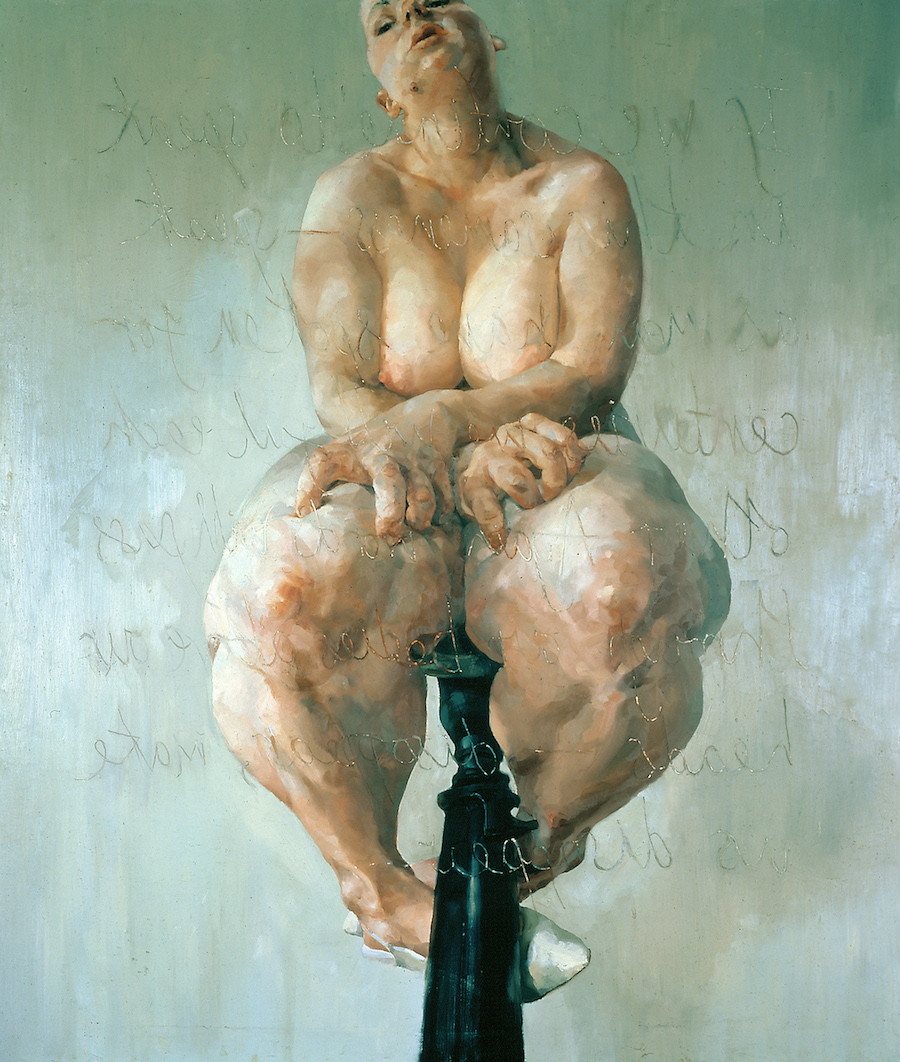
Jenny Saville. Propped, 1992.© Jenny Saville. Courtesy the artist and Gagosian Gallery.
You also had a dialog, this time through an exhibition, with Egon Schiele at the Kunsthaus Zürich last year. What held the most significance to you from that experience?
The whole experience was an amazing journey. As a teenager, I absolutely loved his drawings… the honesty and the brutality of his drawings, of both himself and the females that he was drawing. My aesthetic interest led me to Egon Schiele at a very young age, so when I was asked to do a show together with his work, it was a dream. It was an incredible dialogue.
In that exhibition, the Schiele paintings were imbued with a strong eroticism. Is this also an important subject for you, do you think it is implied in your work?
It has become more and more important, I would say. Instead of erotic in a sexual sense, I would say erotic in a life force or drive. That’s really vital to my work, especially in the drawings, because of the way that I work now. It’s almost like a performance when I’m working, so I do sessions of working for four hours for example, where I draw lots of figures and they start to collapse and then I build them back up again. And through that whole physical process, like a game, new forms start to emerge from the nature of the drawing. So it is a sort of game where you get lost, and through it, you’re almost sculpting out a reality from the process of that moment. It’s almost like a dance or something; you create things that you didn’t know were in you.
Instead of one thing that represents what it is, when you multiply you get closer to a greater nature. That’s become very interesting for me and I’ve only really developed that in drawing because I can change so much and have several toes interlocking, or a male body over the top of a female body and that suddenly become a hermaphrodite. But I’m not drawing a hermaphrodite. I’m drawing many bodies together so that the gender becomes fluid. So parts of the male body become the female body, and that becomes really exciting because it almost represents more what we’re like as humans, rather than these separate sexes. We’re made up of masculinity and femininity, so those are the things that become interesting by layering them up.
Do you feel that you have a body or that you are a body?
Some artists like Michelangelo worked almost with God working through him; he was doing God’s work and there was a kind of divinity involved in it. God has been slipping away for most of us, but when we make work, I’m interested in what the drive is. When I’m working in the middle of the night and I’m trying to get to something, am I working with a wager on God’s existence? I don’t make work for an audience. I don’t make work thinking that I’m going to show this to an audience. But it’s definitely a form of communication. So it’s almost as though there is a third person involved, whether it’s God or whatever. That drives me to go further in the work, and I don’t know what that is.
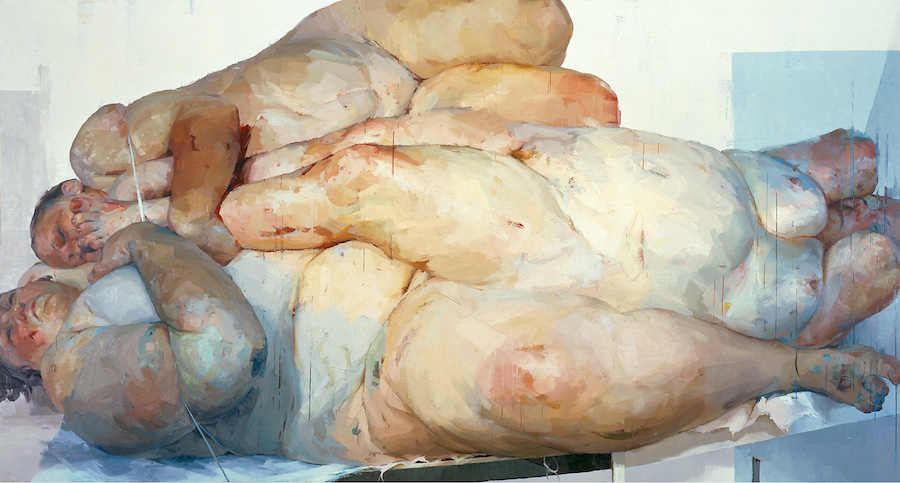
Jenny Saville. Fulcrum, 1998 - 1999. Oil on canvas © Jenny Saville. Courtesy the artist and Gagosian Gallery.
Are you interested in the outside world?
Landscape is hugely interesting to me. Especially the sea… I spend hours looking at the water. I look at the way the light moves on the water. I get up early so that I can see the sun come up. But I don’t want to paint landscape paintings. I’m interested in all of those things. But I’ve never wanted to paint those directly, like I have with the body. And actually, the older that I get, the more closely related to nature I feel, or the more interested I am in depicting that. My mediation is through the body. All of my work really has been a sort of landscape; it’s the landscape of the body, or the architecture of the body in nature, or the nature of flesh, or the way that light affects a body.
What is art to you? What is your definition of art?
I would say the ability to have freedom. That’s fundamental. I really believe in imagination and inventiveness. It’s a combination of factors including humility, incredible hard work – it’s going to take a long time to have any kind of mastery in this – plus being brave enough to take a risk. When, in the work, if I’ve made something look really good and I sit back and think that it is looking good, that’s the moment that I try to destroy it, whereas before I’d polish it off. Now I’ll say well, that was easy access, or an easy journey to get there. Where else can you go? If you’re prepared to do it, you can get somewhere far greater. That takes a lot of hours and a lot of risk, but you’ve got nothing to lose. Why not try to invent something? I have learned through Picasso that the really good art lies in the ability of not knowing how to do something. And the journey of trying to articulate something you don’t know how to do is where the art is. If you know the journey that you’re walking, in a way there’s not much point in walking that journey. It’s in the struggle of trying to articulate something that almost seems impossible, but you’ve got a hint in your initiative to do it, or an instinct, and you follow it. That struggle to articulate it is really where you can find something interesting and Picasso is the artist I’ve found who can do that, so he’s really been a guide for me in the last few years.

- Details
- Written by Elena Cué
British artist Glenn Brown (1966) himself acknowledges and admits the influence that French Post-Structuralist philosophy has had on both his thought and his works. Too much knowledge when contemplating a work of art can prevent the viewer from seeing and experiencing the emotional content of it, but this is counterbalanced by the great stimulus it poses for the mind. At a time when it is claimed that painting is dead, artists like Glenn Brown prove that it is very much alive. He uses a technique that bestows movement to the essence of the subject portrayed. It is as if, by breaking free from classical linear form, he opens the floodgates of its essence, stripping it from its static state and transforming it into an evolving entity. He takes over iconic works of other artists and transforms them.
Author: Elena Cué
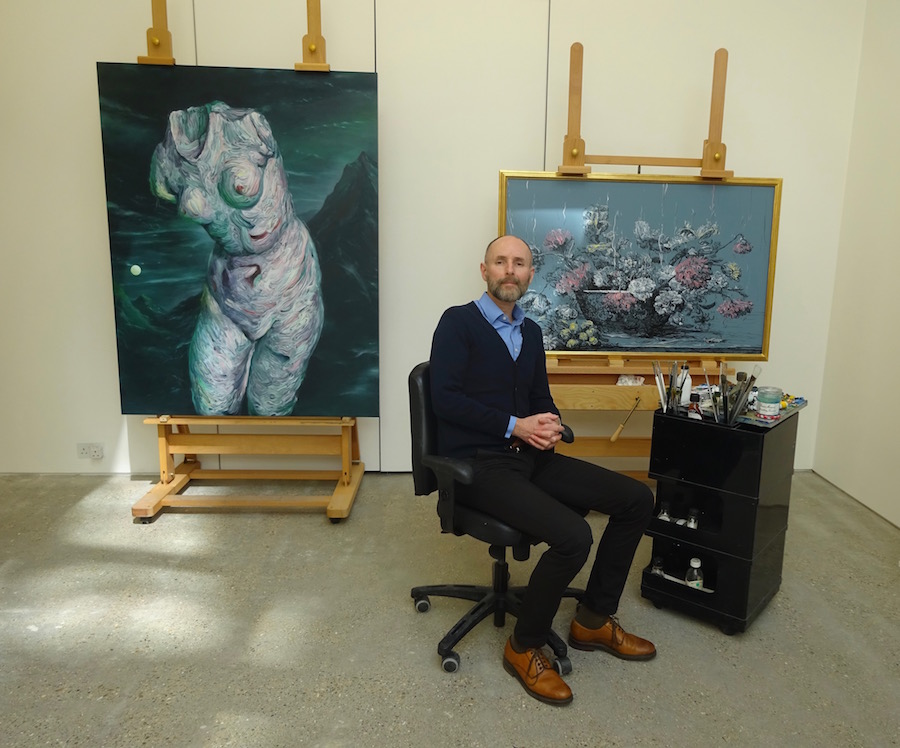
Glenn Brown. Foto: Elena Cué
British artist Glenn Brown (1966) himself acknowledges and admits the influence that French Post-Structuralist philosophy has had on both his thought and his works. Too much knowledge when contemplating a work of art can prevent the viewer from seeing and experiencing the emotional content of it, but this is counterbalanced by the great stimulus it poses for the mind. At a time when it is claimed that painting is dead, artists like Glenn Brown prove that it is very much alive. He uses a technique that bestows movement to the essence of the subject portrayed. It is as if, by breaking free from classical linear form, he opens the floodgates of its essence, stripping it from its static state and transforming it into an evolving entity. He takes over iconic works of other artists and transforms them. He disassembles his images and presents them in a new way. The interconnection and dialogue with artists of the past help develop his own style and render his own interpretation. Opposites, humor, kitsch, even the pleasure of destruction and the fascination for the decomposition of the human form are also characteristic features of this artist.
We begin our conversation surrounded by his paintings in his London studio, where sculptures inspired in the intensity of Van Gogh’s palette will travel to his upcoming exhibition in Arles.
Is the interconnection and dialogue with artists from the past a condition to building your own style and offering your own interpretation?
Obviously, it’s only a one-way reaction. I can only take from them; I can’t give back to them as would happen with artists when they come into the studio. So obviously, artists from the past can’t comment on my work, I can only comment on theirs. But yes, just in the same way that my work is a combination of myself and all of my friends and the people who have helped me make the work, it’s also the case that it is a combination of all the artists that I’ve seen and learned from. And to that extent, you go back to Gilles Deleuze in terms of any individual being made up of the parts of the society that has constructed them. We are part of a rhizome, a structure of society that develops the language with which we think, as if we’re made of language. We can’t exist outside of it.
Where identities are lost and one is with many other...
I’m just trying to make it very clear that all artists borrow from the past and we cannot be wholly original, because to step outside of originality is to step outside of language. To be wholly original would be to be nonsensical. I think the idea of the avant-garde has made people believe that an artist is supposed to return to some childish level of communication, where the inner-self can be expressed directly onto a canvas and the raw emotion that is beyond language and beyond society will come out in some way. Expressionist painting was supposed to be that. Hence why artists like Picasso and de Kooning to some extent were making these thick, grotesque gestural paintings mimicking the work of children, as if they had the real understanding of what it was to be human. I borrow some of their work, as if to say, well yes, you’re partially right that the work of children is raw and interesting and describes something fundamental, but really what you’re doing is a pretence - it’s a game, because you’re being a very sophisticated artist using sophisticated color combinations and nobody really believes that it’s the work of a child. You’re just pretending, like an actor pretending to be somebody. I’m sort of contradicting the idea of the avant-garde, or trying to, which I think is still very prevalent in our understanding of what art is. It’s too dominant in society. Too much importance is given to the understanding of the real, and not enough importance to the idea that there is a shared understanding of society and that we are social beings more than anything else.
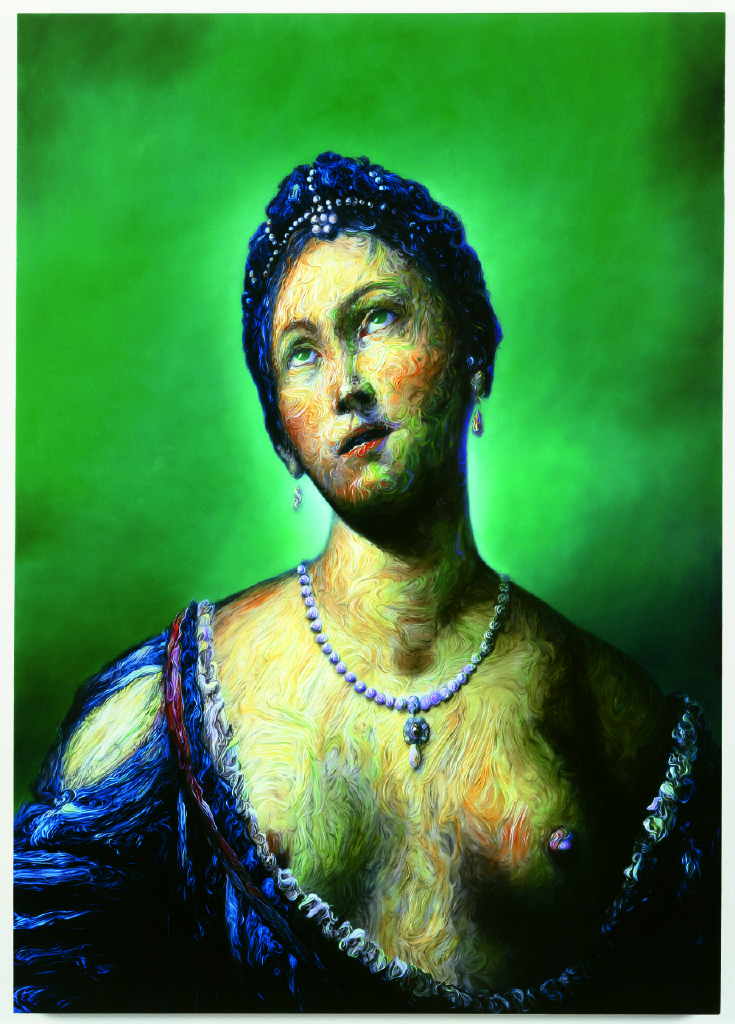
Glenn Brown. Led Zeppelin, 2005. Oil on panel. 122 x 86 cm. Copyright Glenn Brown
Do you think then that style is produced by the forces from which thought springs?
To some extent, through my borrowing of artists as diverse as Gray or de Kooning or Rembrandt or Van Dyck, you could say I don’t know who I am myself, or that I have no particular style because I borrow so much from other people. I am partially saying that I don’t have an identity, I just choose.
Yet your work has its own distinct caracter that can immediately be attributed to you…
Precisely, because it is important as an artist, I think, to have an identity. Otherwise, nobody pays any attention. And although I’m saying it’s impossible to be original, I also believe that you have to try and be as original as possible and make objects that have never really existed before. So I am trying to make a painting that, although it’s based on somebody else’s work, you would never think was from the eighteenth or nineteenth century; it feels very twenty-first century and postmodern. I have particular styles of working, I mean the very flatness of the paintings and my obsession with the brush mark and the way that’s led into an obsession with the line and the movement that I try to create on the surface of the image, to make your eye slide around the image and continually feel that nothing is quite solid and everything is vaporous; sliding and moving and animated.
You said that you are not original and of course we are a combination of our pasts, but there is a tension between that and something in your thought process that can only ever be original.
That is the wonderful contradiction of making anything. You really want to present something and people like seeing new things; human beings are hardwired in their brains to want to see something new that they haven’t seen before. Something that is surprising and they can tell all their friends is different, and they now understand the world as being different to the way it was before. We love the idea of progression; that the human race is heading towards some nirvana where it becomes better all the time. I don’t believe that the world becomes better; I don’t believe that we become more intelligent. I just think things change - certainly in art. I can’t look at art from the Northern Renaissance – I’m thinking particularly of Dutch or German or Italian artists from the Renaissance. But I particularly like Northern European fifteenth and sixteenth century art. I really can’t think that art is better than it was four hundred years ago. I have Hendrick Goltzius’s etching over there of the Pietá, and I just can’t really conceive that art has ever got better than that, in depicting the idea of death and mortality and emotion and flesh and relationships and the way that the sky becomes electric with emotion. It almost predicts the idea of radiation in the work, or the idea that we are made up of atoms. There is something very atomized about that image.
You use a singular technique. With the movement that you imprint over the essence of the human being in your portraits, in order to break the linear way, do you intend for us to change our previous conception of understanding ourselves and the world?
The idea of the movement is that we are never fixed as individuals. Gilles Deleuze talks about the idea of the horse and the rider, and the rider, in understanding the horse, behaves like the horse. The horse behaves slightly like the human being because they both have to understand each other, in order for the rider to be able to ride the horse properly. They predict what each other are going to do, and are therefore joined together. There is a fluidity between the horse and the rider; between human beings and animals, just as there is when we have a conversation and we try to predict what the other person is going to say. Or we empathize with somebody else and that means there is a fluidity between one person and another. Brains almost literally become connected. That is why in a lot of the work, the linear form is trying to describe a literal fluidity - a melting, reforming or maybe rotting. The image decomposes, hence why I like painting flowers, because when they’re just at the point of being absolutely beautiful, they are about to die - cut flowers particularly, are already dead. They’re at the point in which they are at their most beautiful and we want to display them, but in order to display them, we have killed them. I love that contradiction of having to kill something in order to enjoy it. The important point is that the people and flowers and animals that I paint are maybe all appearing to be decomposing, but they are just transforming from one thing to another. The person rots away and then transforms into the soil, whose atoms then become part of the tree. Then an animal comes and eats the tree, and the tree becomes part of them. We all transform from one thing to another, we are all made of stars; the atoms that we’re made up of are billions of years old and once formed parts of stars. So it’s that idea that we are all eternal, to some extent. It doesn’t matter what form we take. We never truly die, we just transform continuously. I think that is also the essence of what it feels like to be human. I don’t feel as if I am absolutely aware of my skin the entire time, I’m not fully aware that I’m an isolated individual in the world. I feel like I’m part of the world, because I know what the street outside looks like and therefore part of my brain is out there in the street. I feel that I know what Russia is like, although I’ve never been there – so part of my brain is in Russia. I think to be human is to be fluid. It’s not to feel closed in. I’m trying to get at that idea of the inside and the outside, that the skin of the human being is translucent and things flow inside and outside. It’s as if the individual’s skin and flesh is turned inside out and we see the inner organs on the outside of somebody, or the musculature and the inner workings of the face all turned inside out, so that you start to see the structures that happen within the skin… I’m obsessed with that… the translucency of the flesh and the transmogrification of something turning from one thing into another. Andy Goldsworthy does that extremely well – the breaking down of one thing into another is done very beautifully, the way the line creates fluidity from one shape to another and then connects to each other. It is nothing original that I’m trying to do; artists have tried to do it for centuries.

Glenn Brown. Reproduction, 2014. Oil on panel. 135 x 101 cm. Copyright Glenn Brown
When you appropriate the paintings of other artists, what is your intent? To destruct and rebuild, or deconstruct and transform?
You do destroy, because it’s an act of homage to take somebody else’s work. People often ask whether I like the images that I work from, and I generally do, but not absolutely all the time. Sometimes they’re just paintings where the most important thing is what I can do to them, therefore I will see aspects of them without fundamentally necessarily needing to like the painting.
How do you choose?
It is something that I think I can transform. I see gaps in the work. It is a very disrespectful thing to do to another artist, to take their work and transform it, so it’s partially an act of homage and partially an act of destruction that I think I do. I’ve used a lot of the work of Frank Auerbach, and I like his work extremely, but I don’t think I could do what I do to his paintings if I wasn’t willing to say, well, I think maybe they don’t go far enough, I think maybe I can improve them… they don’t describe the world in the way I want it to be described, so it’s partially an act of criticism and partially an act of homage. I think it is like the relationship between the father and the son, or mother and daughter, where the two criticize each other immensely but they love each other. Families quarrel. Children want to rebel against their parents and tell their parents that they don’t know anything, that they misunderstand the world and that they know better. And all of those things are healthy, because fundamentally, we are our parents - they’re the biggest influence in our lives. So even though we rebel against them and hate them sometimes, they are us. It’s that same relationship of the parent and the offspring that I think I have with artists and art history. I love them and hate them in equal measure. To that end, when my father sees my work, he gets it immediately. He understands my work immediately. He’s my harshest critic, because he will sometimes see a painting of mine and say, you’re not trying hard enough with that one; you’re just trying to get away with it… you think you’ve done something that is good enough, but you can do better. He will point out bits that he doesn’t think works in them, and he is generally right as well. He knows the way my mind works. He is very helpful. It can be quite difficult sometimes, because he’s harsh… but good!
Opposites are very present in your work: figures between life and death, ugliness and beauty, opposite meanings of the paintings and their titles… Do opposites provide greater meaning?
They animate the painting. It is those strong emotions, when you see a film or you read a book and it takes you from a point of absolute elation to absolute disaster, and then back again to being elated. As human beings, we love to be told stories that make our heart beat faster and then calm us down. I don’t know fully why human beings like that; it gives us a sense of adventure, I suppose. I think as hunter-gatherers, we are hardwired to be interested in opposites because extremes can be very dangerous and we know we need to avoid them, very often. It all goes back to dreaming, as well. The reason we dream is to analyze all of the events that have happened in the previous day; to categorize them, to decide which are important and which we need to discard because it’s information we don’t need. It’s a sort of protection that goes back to hunter gathering. We want to know how the animal might behave, therefore we think, I need to think like an animal if I’m going to catch it. Again, going back to that fluidity of one thing flowing into another and the dream world being part of the actual world, and what differences there are between the two. You can’t really have a hierarchy; you can’t have the dream world without the real world.
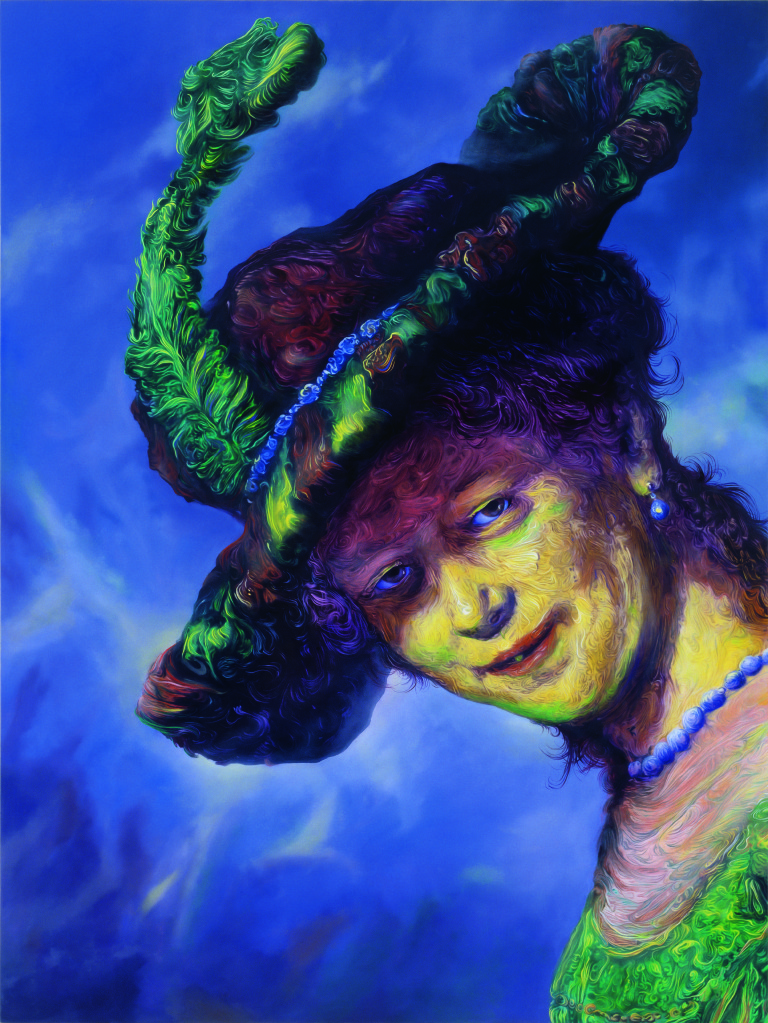
Glenn Brown. Dark Star, 2003. Oil on panel. 100 x 75cm. Copyright Glenn Brown
The titles of your paintings are opposite to the meaning of the painting. What role does humor play in your work, so obviously present in the recycling of titles?
I like black humor… humor that is quite cruel. It appears to be nonsensical, but it’s about atomization basically, and it’s about the electricity between the couples. It is meant to be playing the game of having nothing to do with it, because there’s the idea of the human scale and the idea of the nuclear scale - which we perceive as either being very big or very small – with the human being in the middle. So there are opposites in scale within the idea of nuclear reaction. But it’s the electricity or the dynamism between the couples relating to the way they fight and argue with each other, yet love each other. And the way the marks are flying off, it’s as if the atoms are starting to break down and the radiation is destroying them. The idea of the destructive but creative power of radiation is in the work as well, because you don’t know whether the lines are flying off and breaking the figures apart, or whether everything is coalescing and forming back into itself again. There is a painting based on Zurbaran’s ram called Spearmint Rhino - it’s very big. Spearmint Rhino is a series of strip clubs, where women take their clothes off. And so you look at the picture of this ram, which appears to be decaying and smelling rather badly, wondering what this has to do with a lot of American strip clubs. And the ram is about entertainment. We have tied up the ram and killed it; it’s been sacrificed and killed for our entertainment. The reason we sacrifice things is illogical.
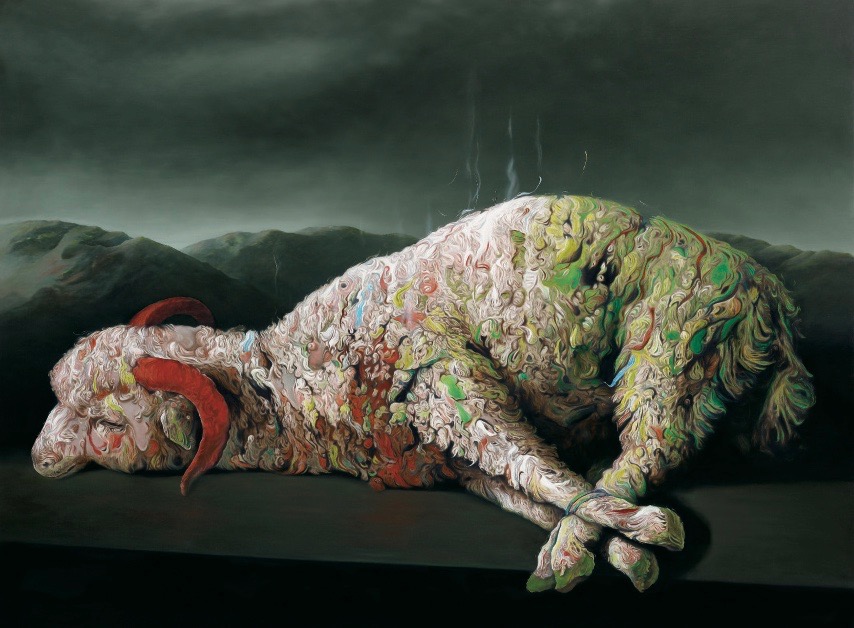
Glenn Brown. Spearmint Rhino, 2009. Oil on panel. 194 x 260.5 cm. Copyright Glenn Brown
What meaning do you give color?
I do generally take color from other artists. I will look at books by Kees van Dongen or Van Gogh or Ernst Ludwig Kirchner. But certain artists – especially those around the turn of the nineteenth century and into the twentieth century – where they just tried their damndest to be as extreme as possible with color and really question what was possible, in terms of representing the world. And what happens if I make a painting where the sky is red, the trees are blue, the sea is purple and everything appears to be the exact opposite of what you’d expect it to be? But somehow by being the opposite, it doesn’t become unreal, it just becomes heightened reality, as if he is describing what is really there and we just haven’t seen it yet. I am just learning and stealing color from other artists, in order to try and heighten the theatricality of the real world. And not all of my paintings have very heightened color in them; for the last few years, I’ve been really concentrating on drawing, which has no color in it at all. Some of my paintings are black and white, where I’ll do the exact opposite, I’ll take all of the color out – or as much color as I possibly can – because even when you make a black and white painting, it’s never purely black and white. You get warm areas and cool areas. But I do like the way color describes emotion.
As a primarily figurative painter, how do you feel about the destruction of form, such as can be seen in your Auerbach-inspired paintings?
In a lot of the paintings, the original has become turned upside down, distorted and made abstract, in essence. You can’t recognize what I’ve painted anymore, though I have destroyed the original form and it’s been broken down into a surreal blob. There are a whole group of paintings that I call my blobby paintings, because they are not one thing. They appear to be renditions of a form, a blob, it’s at the point at which it could change into any one thing. You can’t really decide whether it is figurative or abstract, for instance, in a painting . But there are heads and figures you can see within it, so it’s at once both very figurative and very abstract as it transforms from one thing to the other. It has that fluidity of line, as though it is melting, or like chewing gum.

Glenn Brown. New Dawn Fades, 2000. Oil on panel. 71.5 x 62 cm. Copyright Glenn Brown
What stimulates you more, knowing the world or helping others think through your art?
I like that question. It brings to mind the idea of which is more interesting: experiencing something or reading about it, for instance. Like a lot of people, I would probably say that I like the experience of reading about something. I like the second-hand enjoyment. For instance, I like looking at paintings and portraits, because I like traveling the world through art, in many ways. Especially in the way that painting allows you to travel through time. You can go to the sixteenth and seventeenth centuries through paintings, in such a fantastic way. Not just because they’re literal renditions of what it was like to live in those centuries, but also how people felt in the sixteenth and seventeenth centuries is different to how they feel now. Their ideas of beauty, their ideas of pain and what death meant to them was incredibly different. People were surrounded by death and therefore I probably find the enjoyment of somebody else’s description of something slightly more interesting than actually being there. To travel to China and to go to the Great Wall of China is nice, but to read about it is much more interesting. I can only really appreciate the world through the stories told about it.
